In the previous sequel of my stories, I have written about taking a local train from Besançon to Belfort. Needless to say, it is slower than the fast TGV, but, if you have the time, this is a very pleasant ride. You go through exceptionally lovely landscapes, mostly following the valley of the Doubs river.
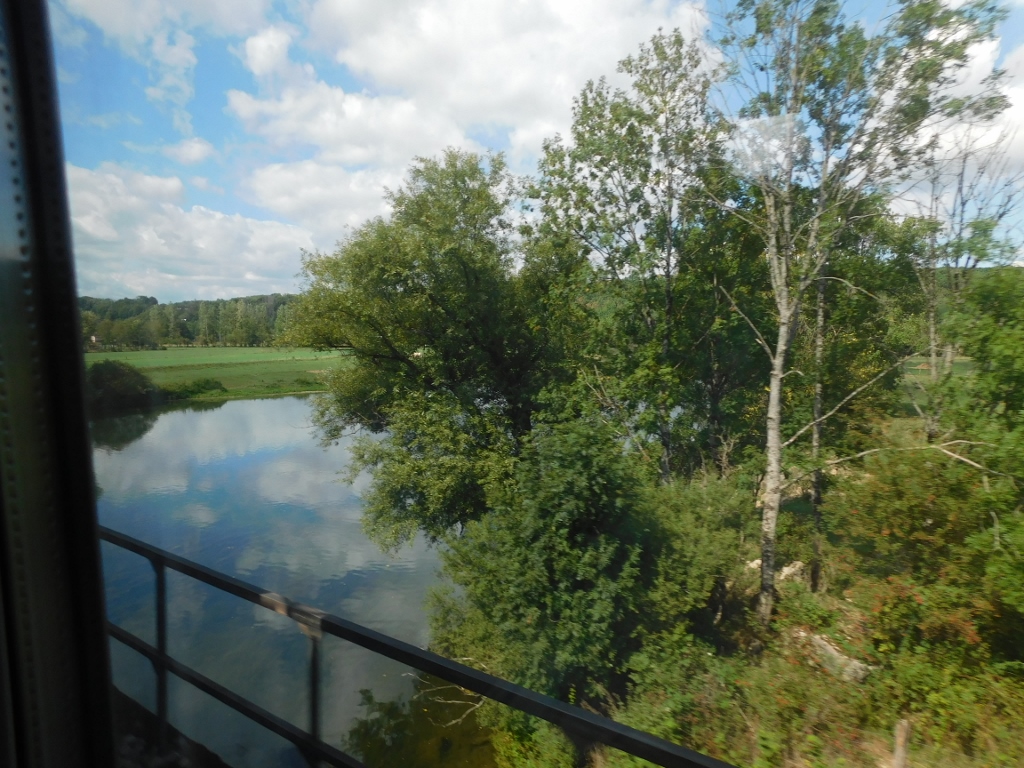 On the way from Besançon to Belfort
On the way from Besançon to Belfort
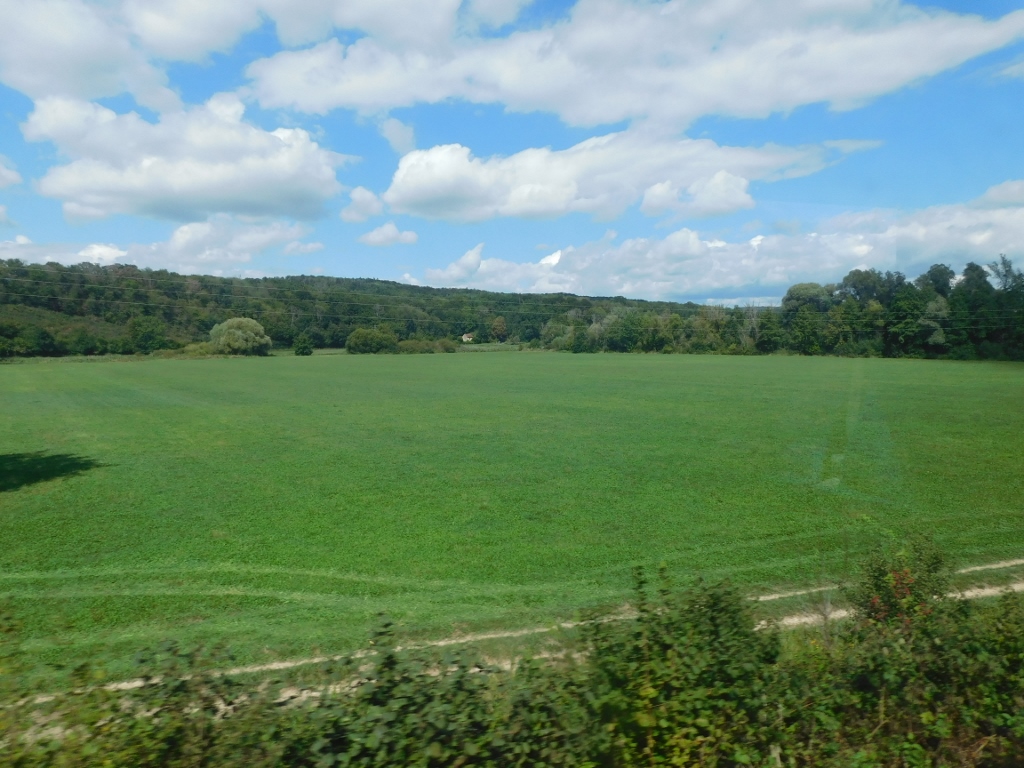 On the way from Besançon to Belfort
On the way from Besançon to Belfort
During one of the sections, the railway runs parallel to the Rhône–Rhine Canal (Canal du Rhône au Rhine) that practically provides river navigational link between the North Sea and the Mediterranean Sea. The canal was built at the end of the 18th and the beginning of the 19th centuries (it was completed in 1833), but today it is mostly used for smaller vessels and yachts, and much less for barges.
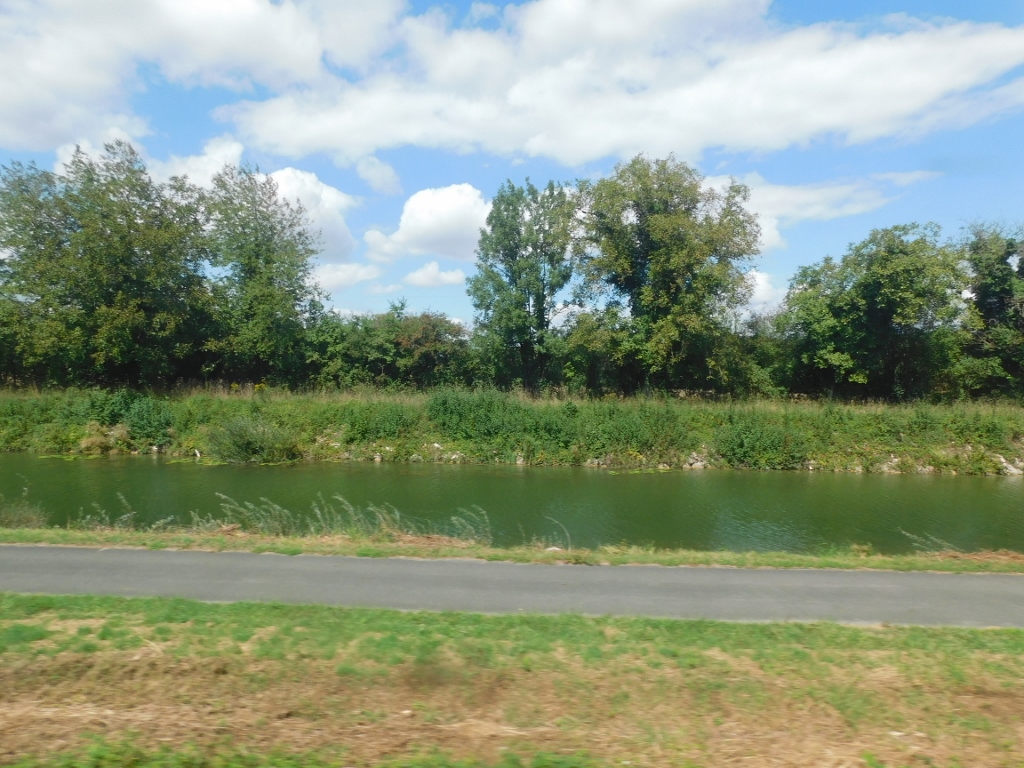 Part of the Rhône–Rhine Canal
Part of the Rhône–Rhine Canal
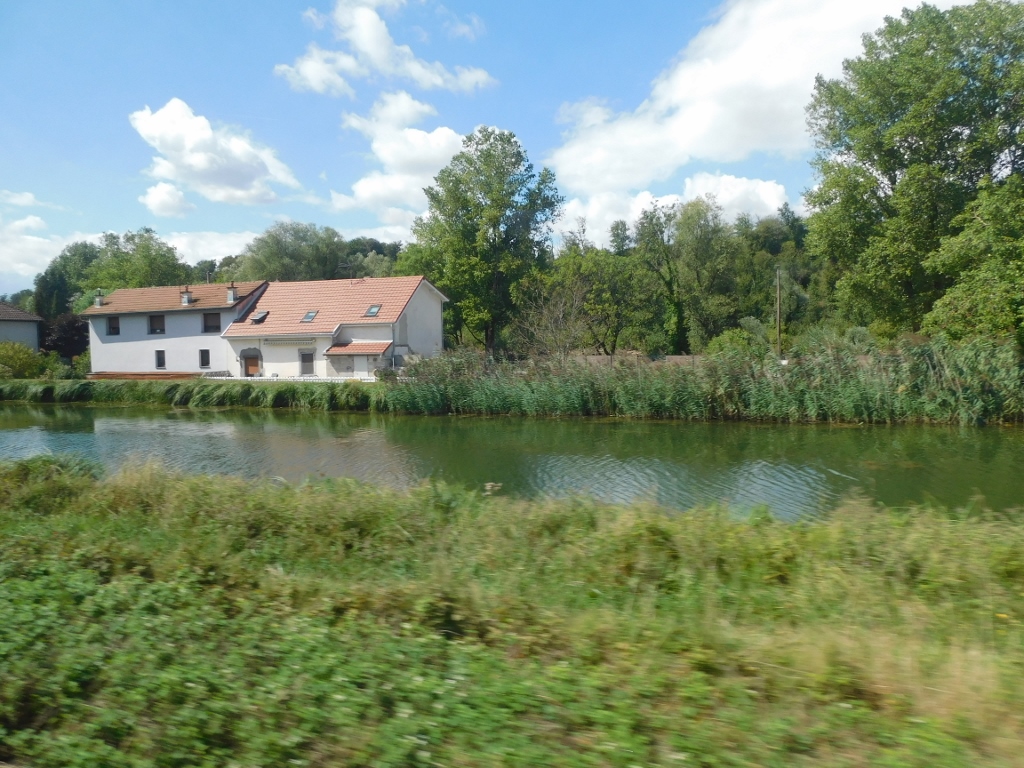 Part of the Rhône–Rhine Canal
Part of the Rhône–Rhine Canal
In the town of Montbéliard I could also see a castle of the same name from the train.
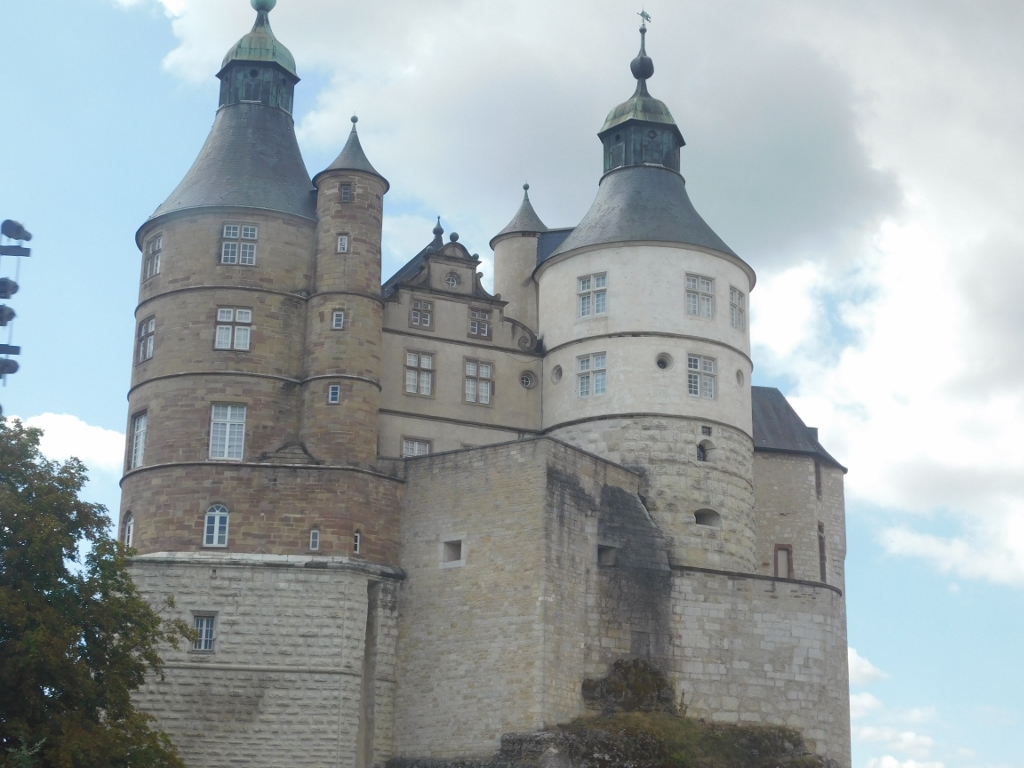 Montbéliard Castle
Montbéliard Castle
Of course, at some point I did reach Belfort where I started with my walk from the railway station to the centre. It takes around 15 minutes or at least twice as much, if the breaks for taking photos are made as often as I tend to do.
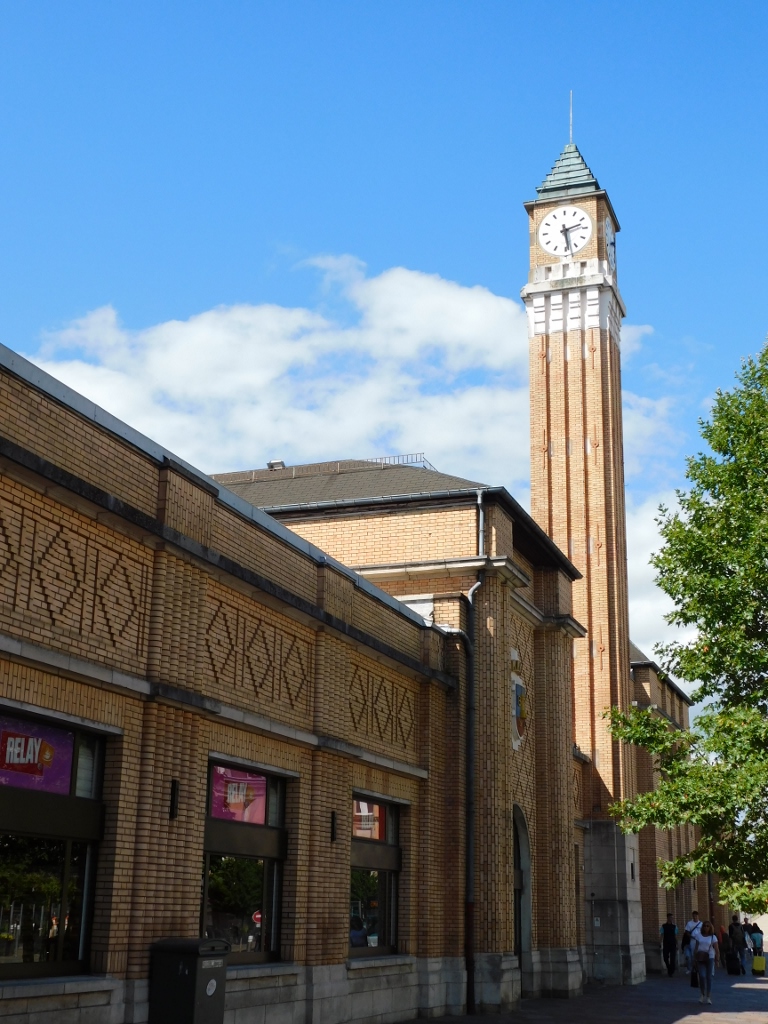 Belfort: railway station building
Belfort: railway station building
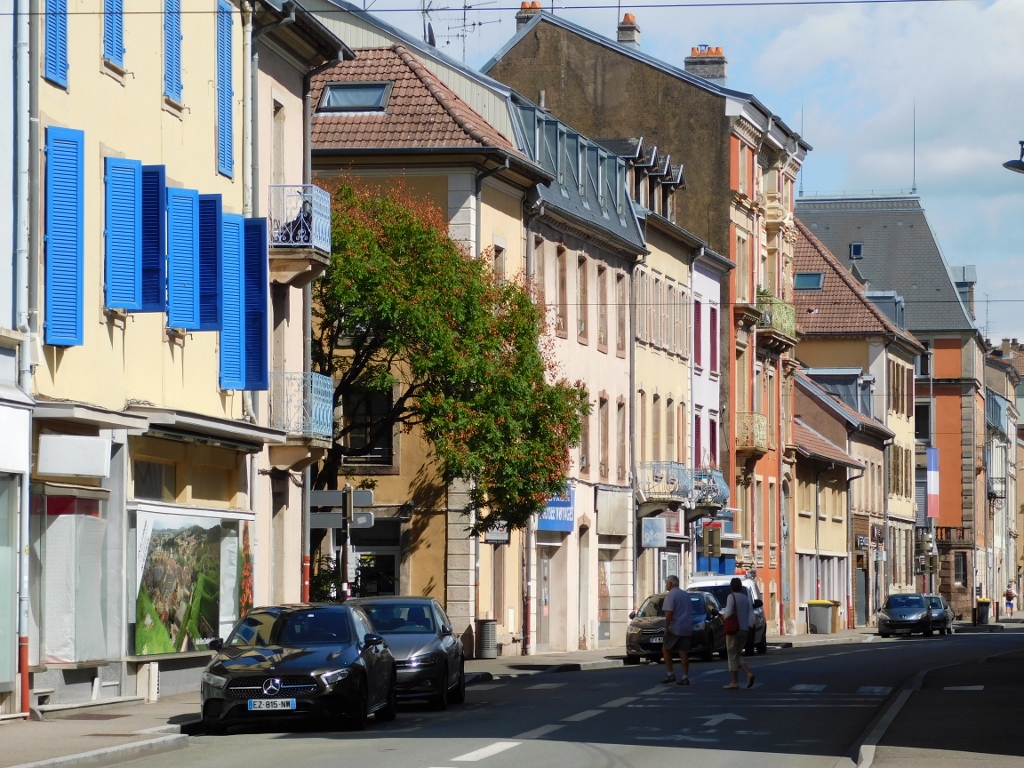 Belfort, a detail
Belfort, a detail
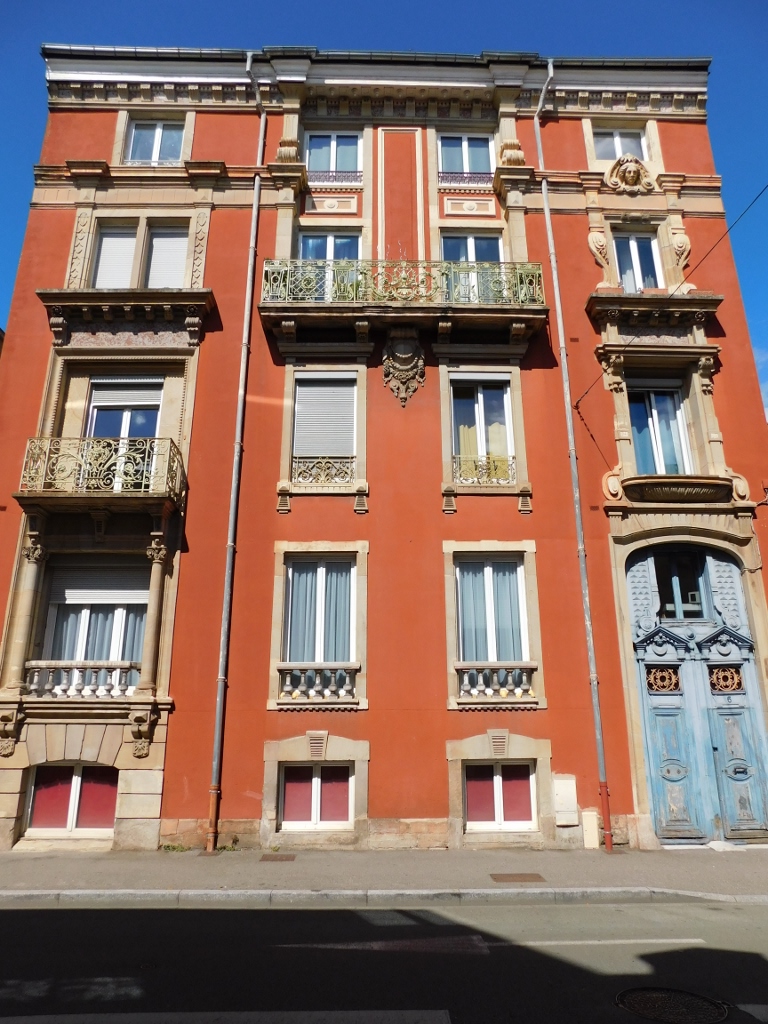 Belfort, a detail
Belfort, a detail
At some point, I noticed a “beast” in the sky. At first sight it was not quite obvious what this was, but after a couple of seconds the situation was made clear – this was one giant flying kite.
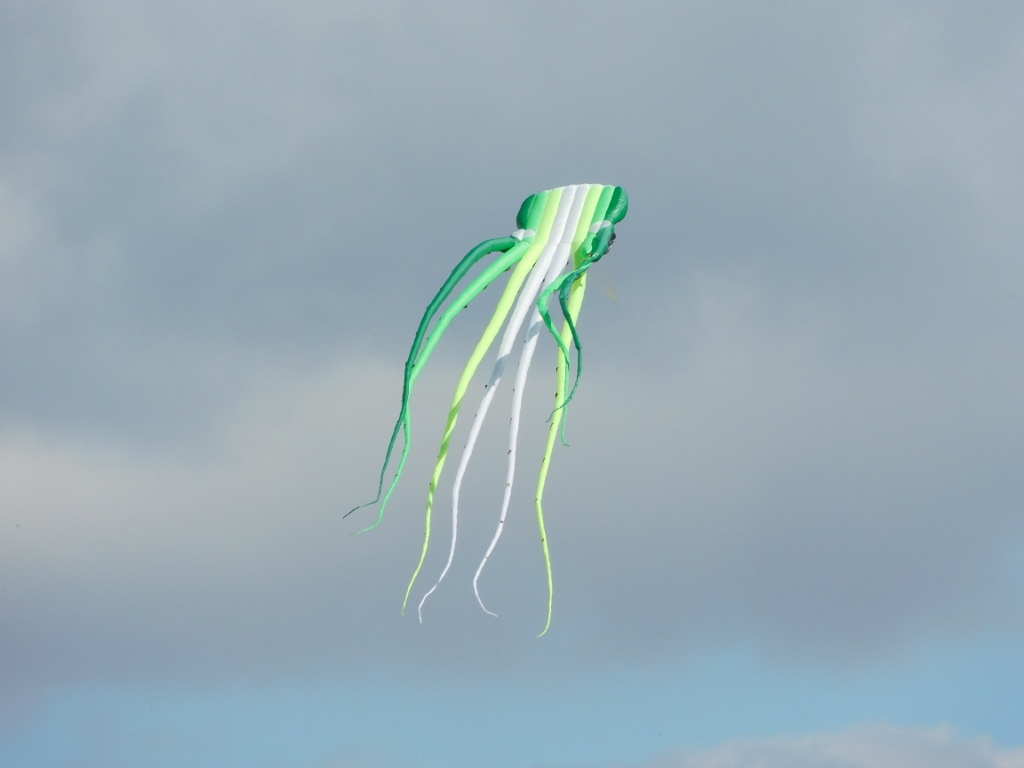 Flying kite above Belfort
Flying kite above Belfort
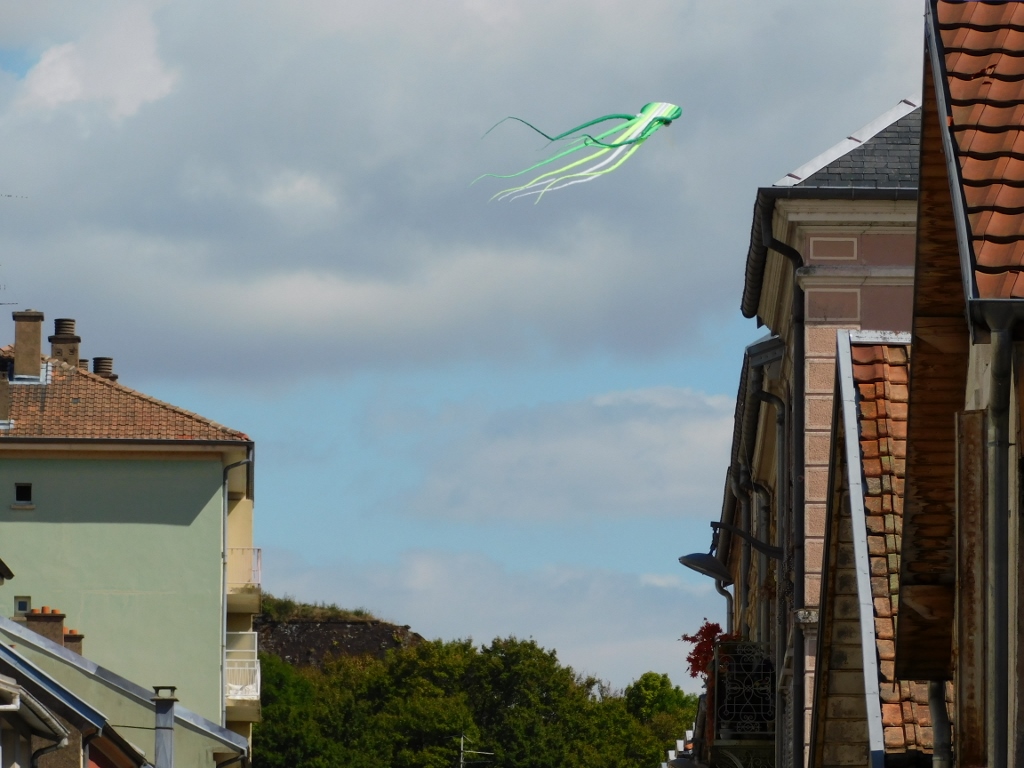 Flying kite above Belfort
Flying kite above Belfort
A small river called the Savoureuse flows through the city and my walk entailed the crossing of the river in order to get to the centre of the place.
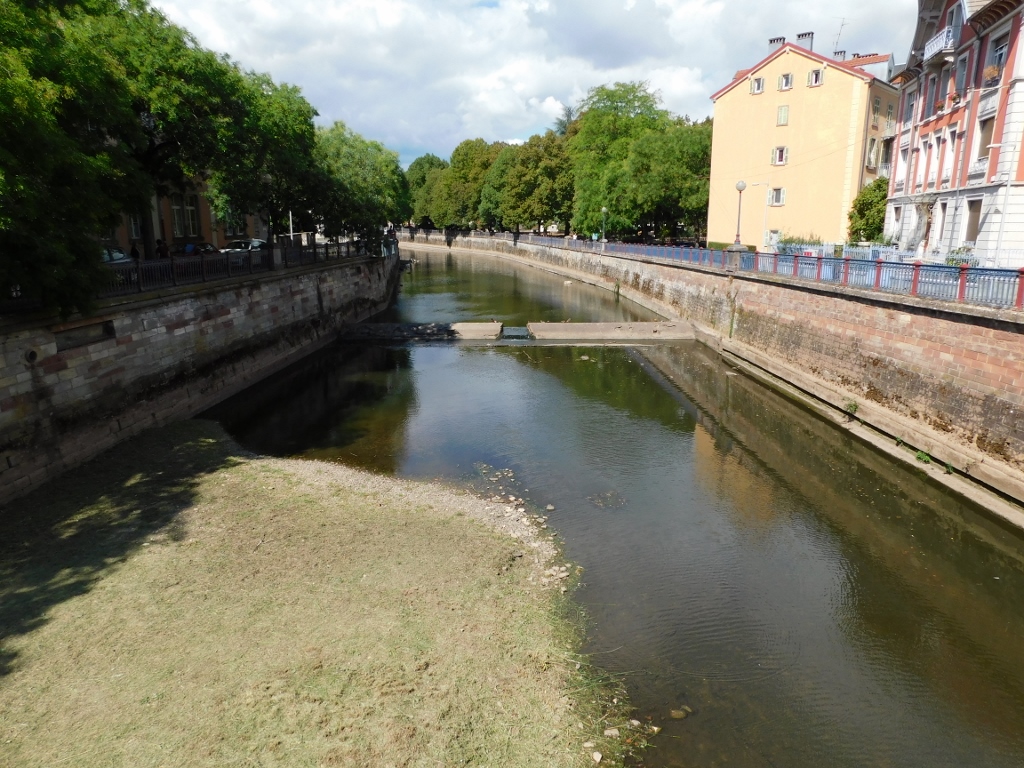 The Savoureuse river in Belfort
The Savoureuse river in Belfort
As for Belfort, the guidebook that I used did not consider anything else apart from the sculpture of the Lion of Belfort worth the while, so I headed towards the citadel since that is where the sculpture is.
Like Besançon, Belfort also has its citadel at a hill above the city, but this one is smaller and significantly less preserved than the one I had already seen in Besançon. As far as I could get it from the guidebook, the fortification in the shape of a pentagon that used to cover all the city back in the day was almost a masterpiece, but because of the development of the city and the need to expand it, the ramparts in the flat part of the city were torn down in the 19th century.
As for the lion, I could see it partially from one of the side streets and it was only then that I realised what a huge piece this was. Before coming here, I had seen some photos, but at least those that I fleetingly saw on the internet did not provide the true idea about this enormous sculpture or perhaps realising the true size of the sculpture is possible only when one comes here. In any case, after I had noticed the lion for the first time, I soon arrived in the spot from which I could admire it better.
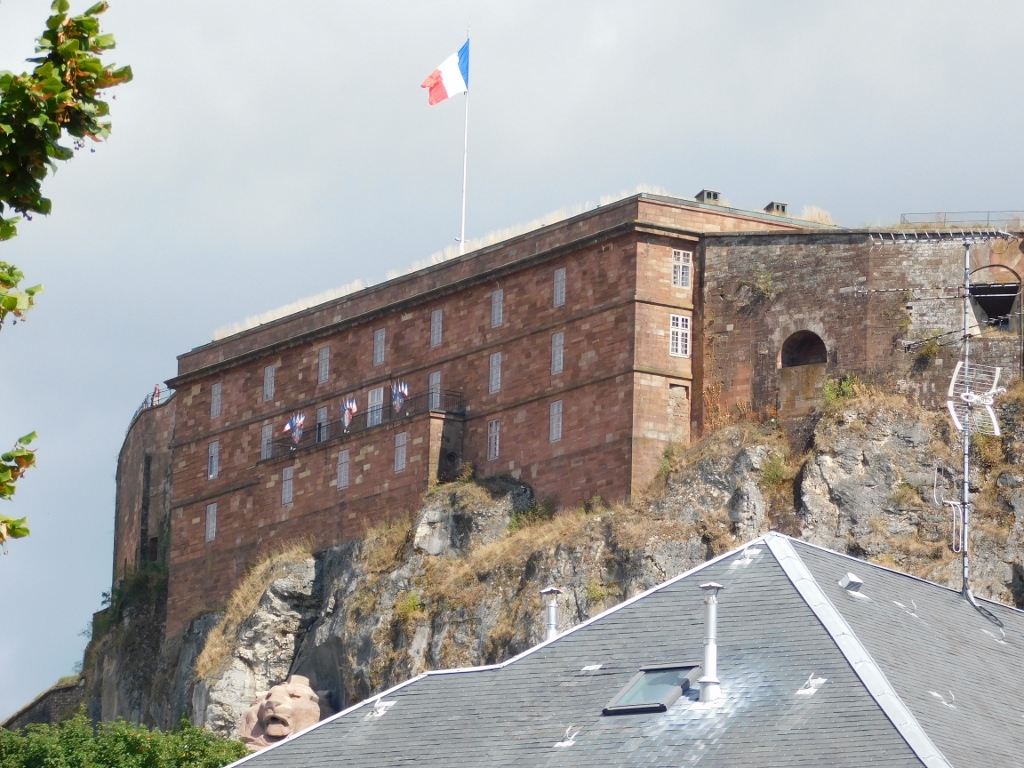 Belfort Citadel – spot the lion (you can see only its head)
Belfort Citadel – spot the lion (you can see only its head)
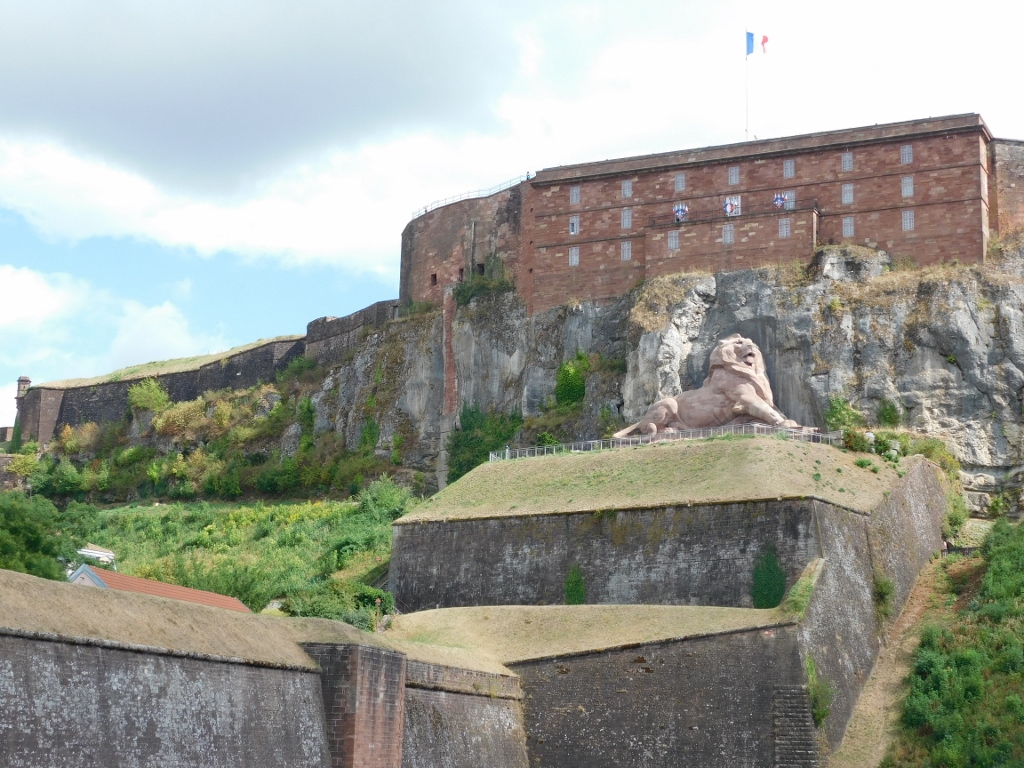 Belfort Citadel, while the lion is below it
Belfort Citadel, while the lion is below it
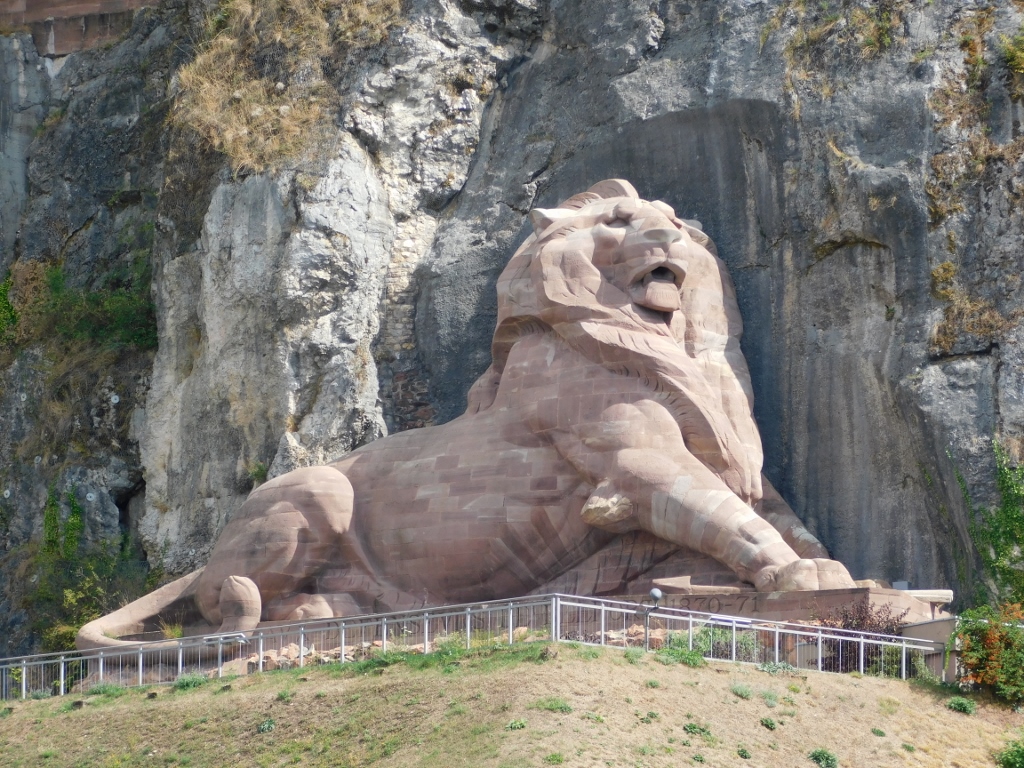 Lion of Belfort
Lion of Belfort
This was inevitably a moment to remember a poem by Duško Radović “Terrible Lion” which is one of the most famous among the children in Serbia:
Once upon a time there was a lion
What kind of lion?
A terrible lion,
all ruffled and angry!
That’s terrible, that’s terrible! ...
And yet, this lion, after all, just like the one from the poem (which is, by the way, a mere drawing), was not so terrible in the end, but it was certainly impressive!
The Lion of Belfort is a colossal statue that was made in 1880 out of red sandstone by the famous French sculptor, Frédéric Auguste Bartholdi. I have already written about him in (https://www.svudapodji.com/en/fgs-11/) and he is most famous for being the sculptor of the Statue of Liberty that adorns the entrance into the port of New York.
The sculpture of the Lion of Belfort is 11 m high and 22 m long, and it was put here in order to symbolise the heroic defence of the city from 1870 to 1871, during the Franco-Prussian War.
I must admit that I had no intention whatsoever to climb up to the Lion or the Citadel for that matter. One military fortification a day is quite enough for me.
What I did after taking photos of the Lion from different angles and using my zoom was to go to the main square in Belfort where I took a seat and had a red beer. In comparison to the previous days, I did not walk too much on this one, but I was relaxed enough that it felt very good to make such breaks.
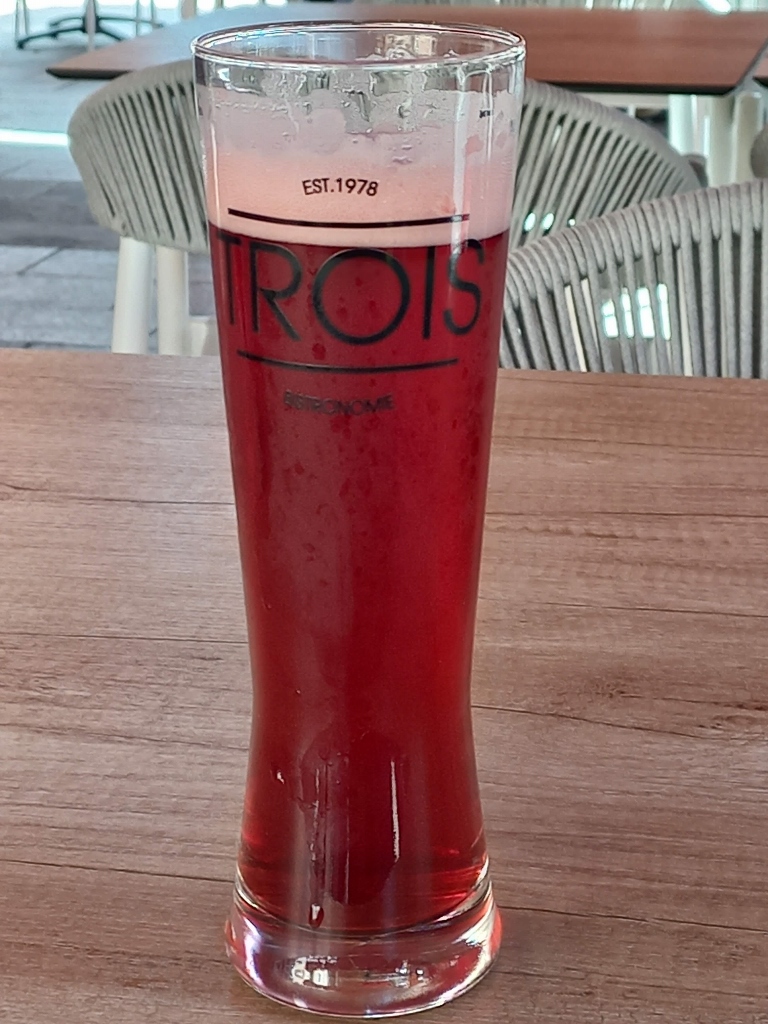 Beer in Belfort
Beer in Belfort
After this break I felt like walking a little around the centre of the city. Although Belfort is in no way popular among the visitors as the other places I had been to during the previous days, this is a lovely city nonetheless and I quite enjoyed the stroll.
To start with, I made a circle around the square itself, called Place d’Armes. There I saw the Cathedral from the 18th century, but my attention was first drawn to the “beach” in the middle of the square.
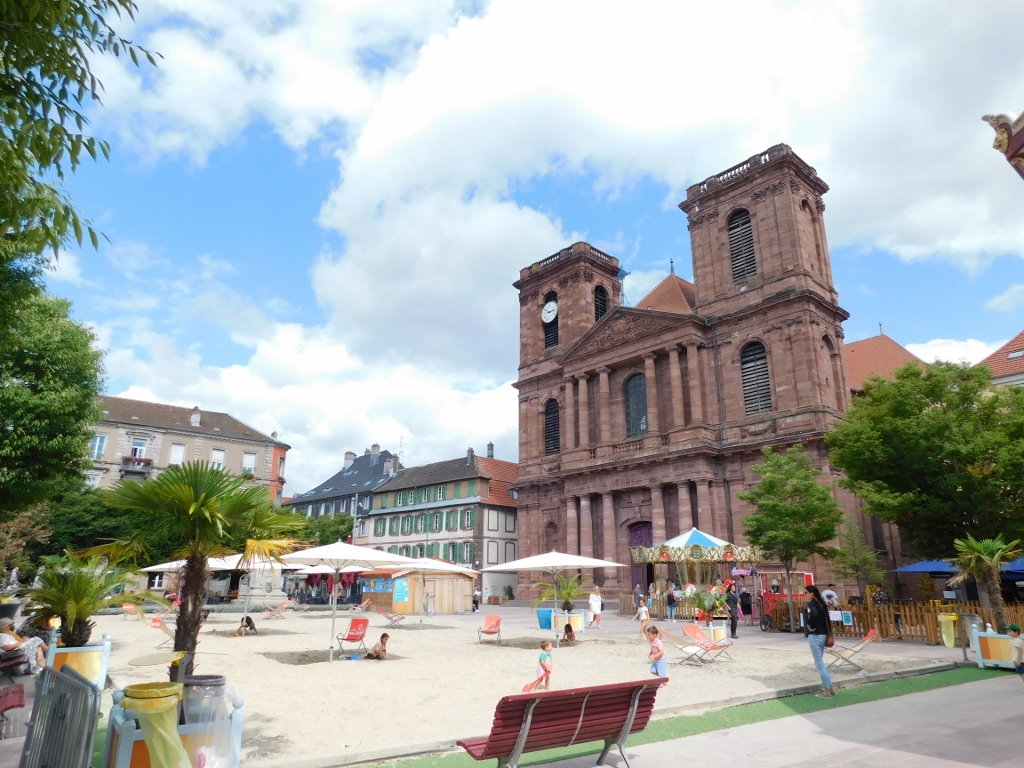 Main square in Belfort
Main square in Belfort
I found it cute that the city authorities had decided to deal with the lack of a sand beach in the city by installing one themselves and this one was duly equipped with deckchairs and big parasols.
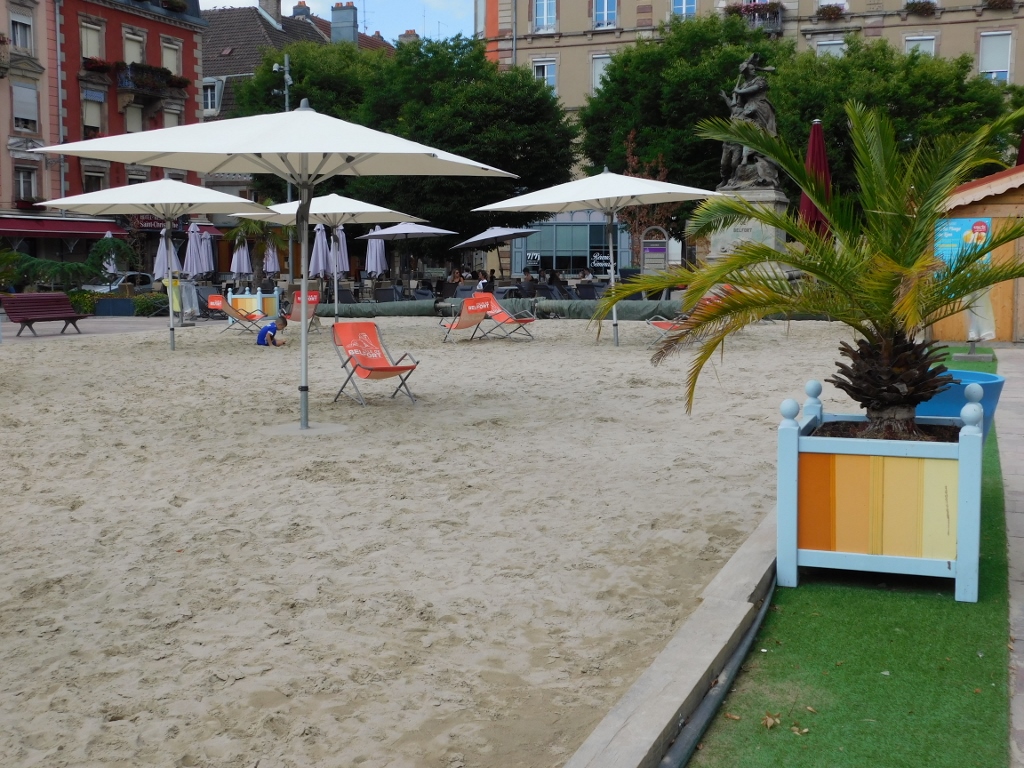 Beach in the main square of Belfort
Beach in the main square of Belfort
Then I entered the cathedral that was, just like the Lion, made of red sandstone. The cathedral has the status of a national monument, while its organs are categorised as a historical monument.
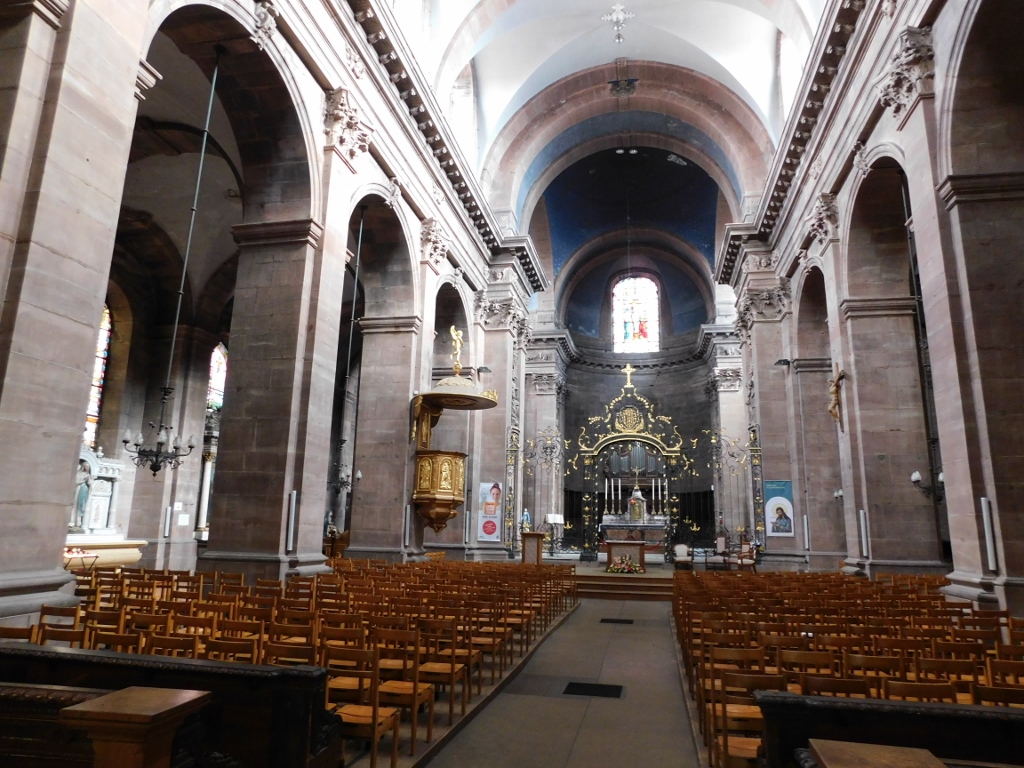 Belfort Cathedral
Belfort Cathedral
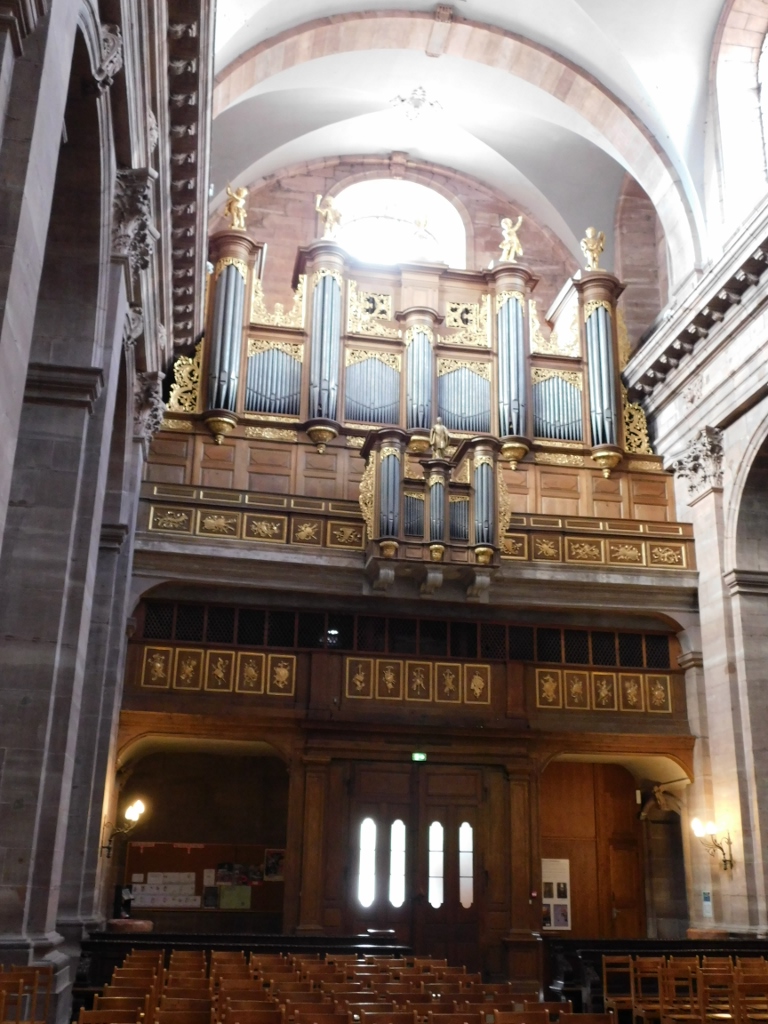 Belfort Cathedral
Belfort Cathedral
 View at the main square in Belfort
View at the main square in Belfort
There is also the City Hall (Hôtel de ville) in the square and it was originally built in 1722-1724 as a private palace.
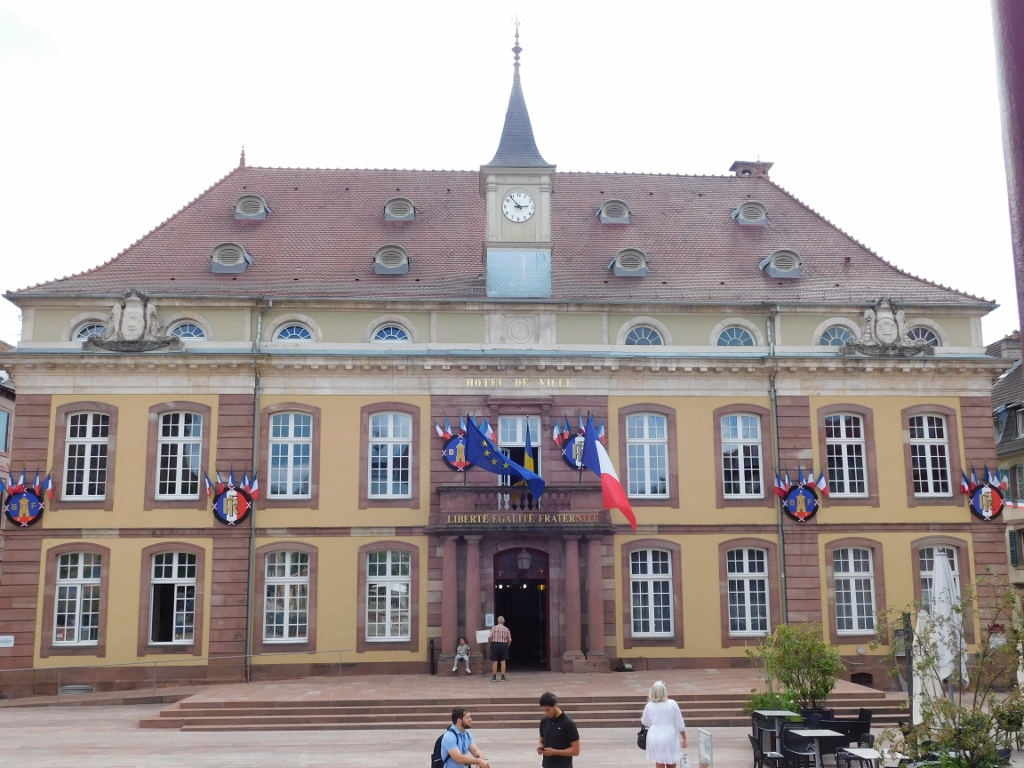 City Hall
City Hall
Just like any other place, Belfort also has its naughty and disobedient citizens who every now and then need to be detained. Here is a local prison or better said a detention centre as well.
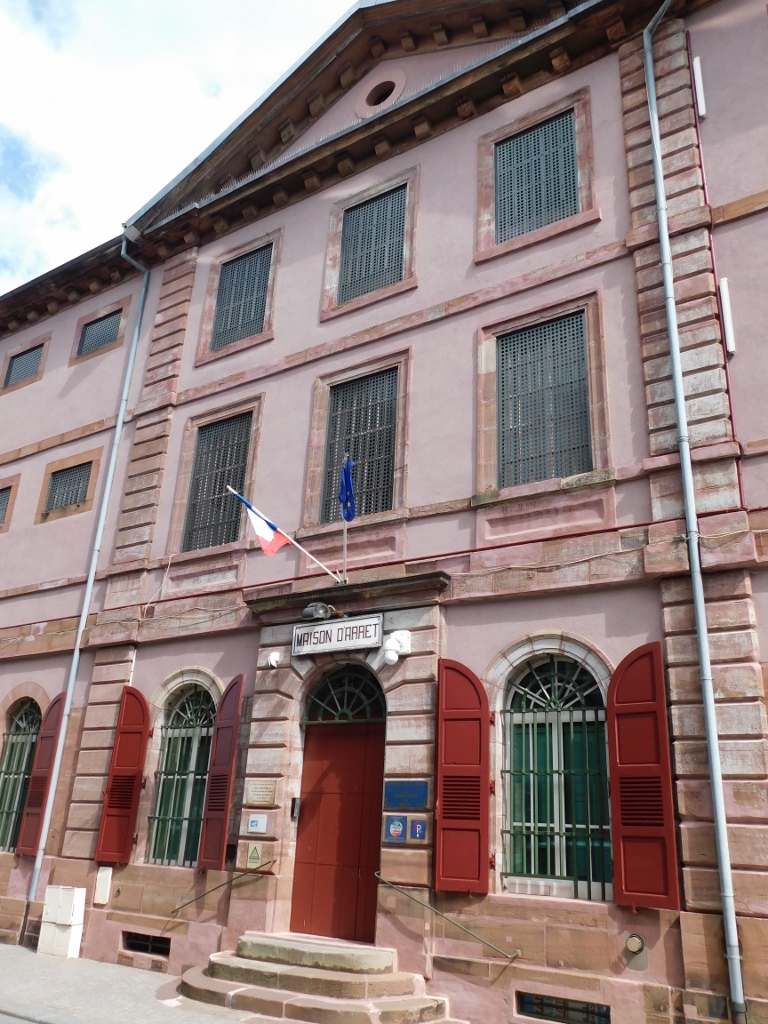 Prison in Belfort
Prison in Belfort
And then I came again to a spot from which I could admire the Lion of Belfort. In the photo below, you can also see two persons standing close to the Lion, which provides a good illustration about the true size of this sculpture.
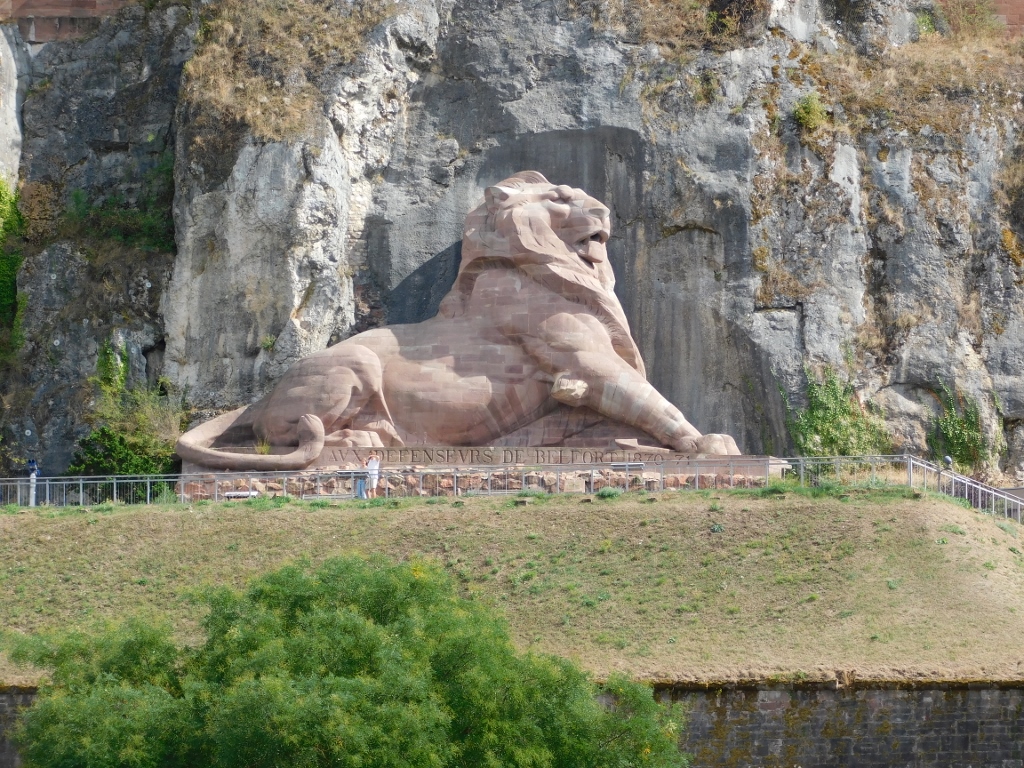 Lion of Belfort
Lion of Belfort
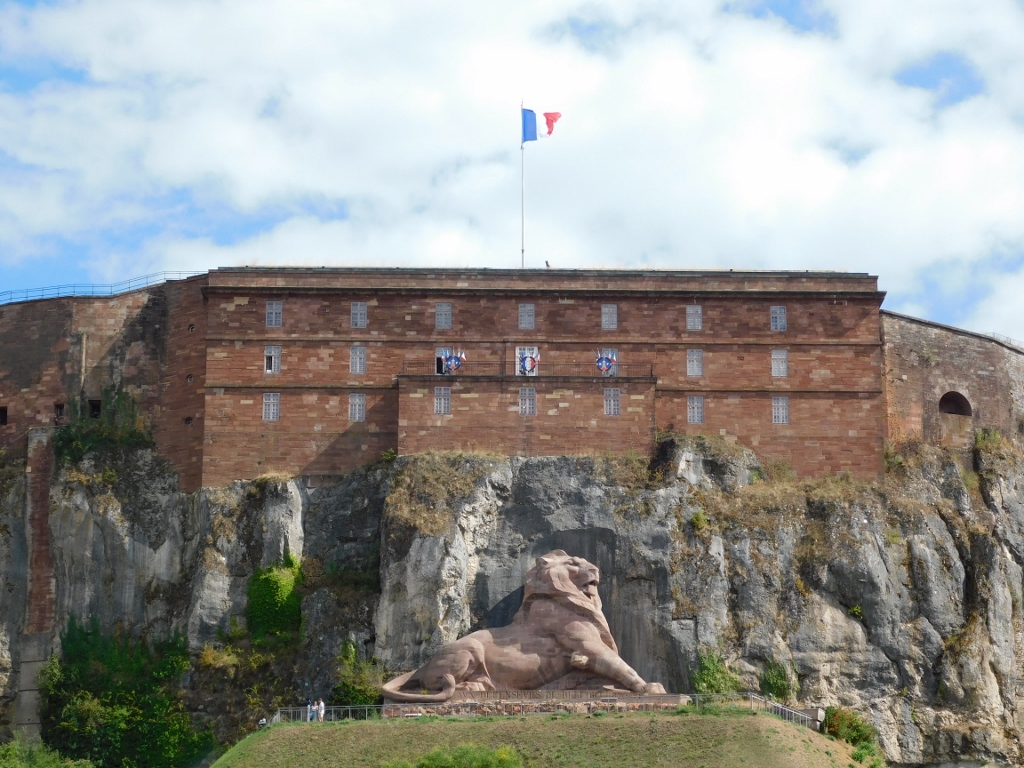 Lion of Belfort
Lion of Belfort
I also walked past a surviving bastion from the end of the 17th century, called Tower 46 (Tour 46), which is nowadays used as an exhibition hall.
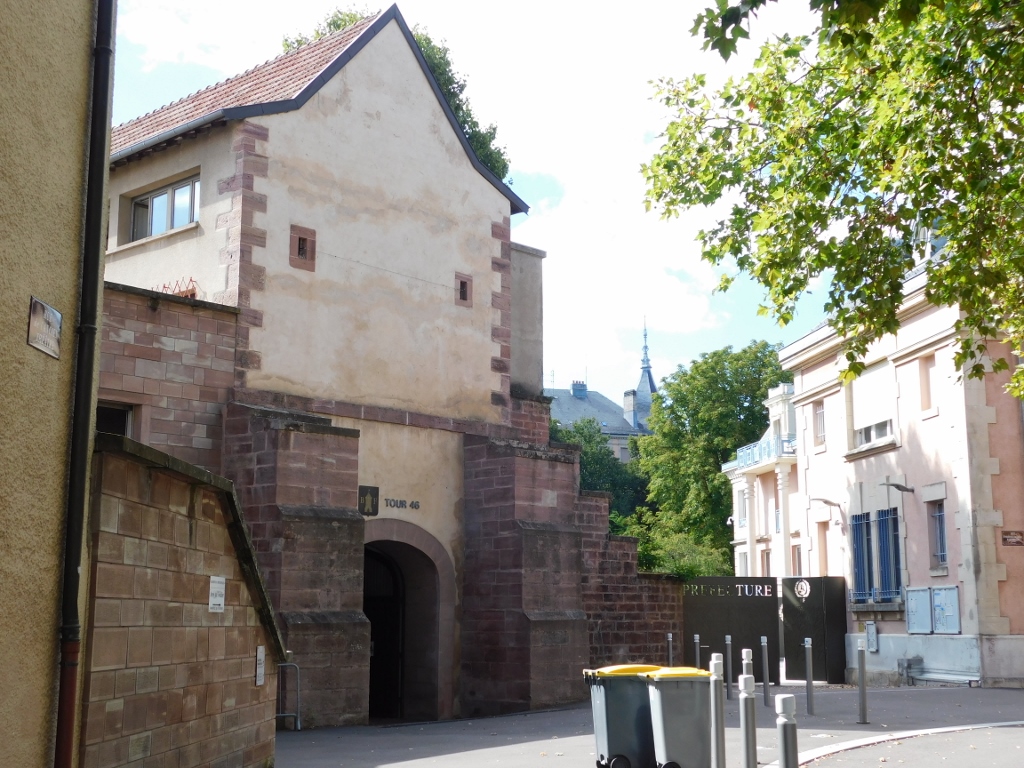 Tower 46
Tower 46
But, the centre of Belfort has some different buildings as well, like a big hotel I passed by. This is a lavish edifice from 1907 that at the time quickly became the most exclusive venue in the region.
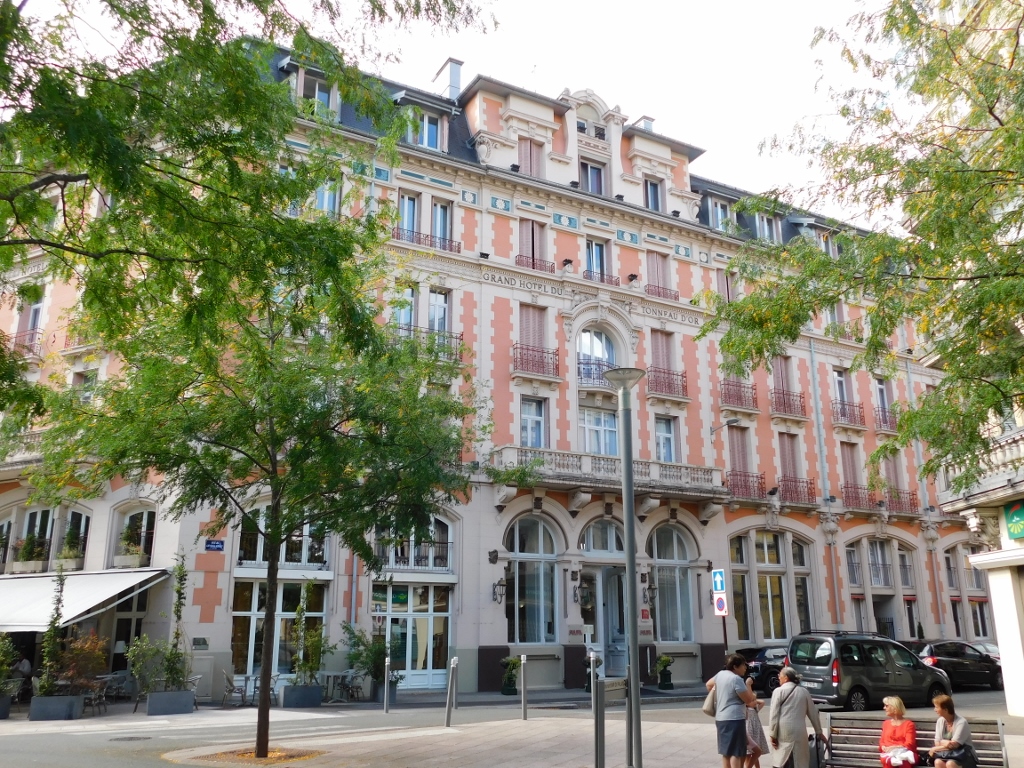 A hotel in Belfort
A hotel in Belfort
Having returned to Mulhouse, later that afternoon I finally started to walk around the town. On the previous days, I returned either late or was too tired or was too sweaty (on account of the high temperature combined with high air humidity), so I could hardly wait to go back to my room, have a shower and relax.
This walk now was not a problem, since the centre (the main square) was only a dozen minutes away from my room.
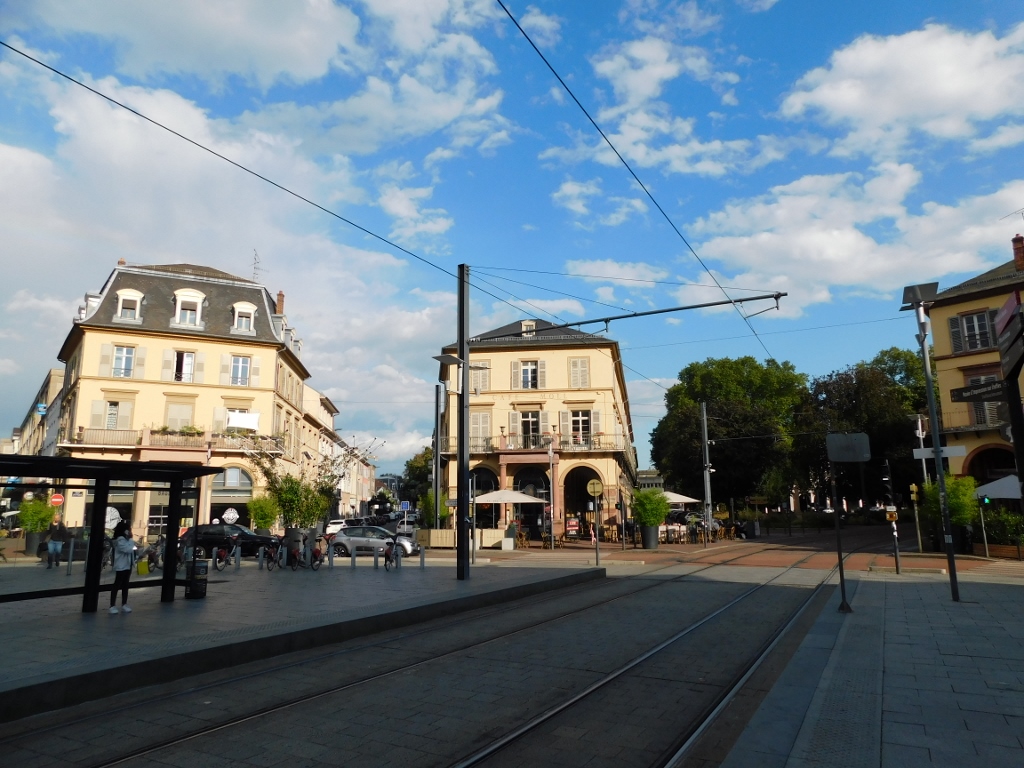 Republic Square in Mulhouse (Place de la République) near which I had a room
Republic Square in Mulhouse (Place de la République) near which I had a room
Arriving in the main square of Mulhouse I was reminded about how lovely this place actually is, which was what I did remember from the first time when I only very briefly came here during some journey of my past.
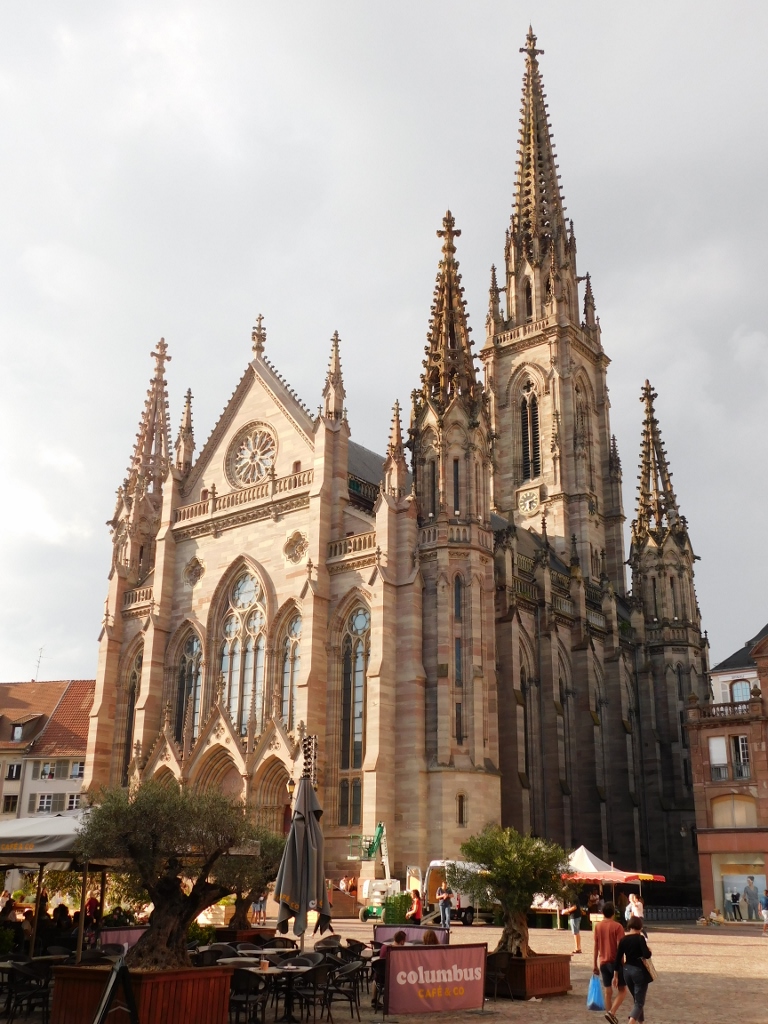 Church of St. Stephen (Temple Saint-Étienne)
Church of St. Stephen (Temple Saint-Étienne)
Because of its size and the position, the protestant Church of St. Stephen in the main square of Mulhouse, built in 1859, is often called a cathedral, but it only replaced in this spot an earlier church from the 12th century.
Here in the square, you can also see an exceptionally beautiful Town Hall (Hôtel de Ville) from 1552. Its construction style is unique in France (the Rhineland Renaissance), with the decoration of the facades being done in 1698 and this is what can be seen on this impressive building. The second storey was added later on.
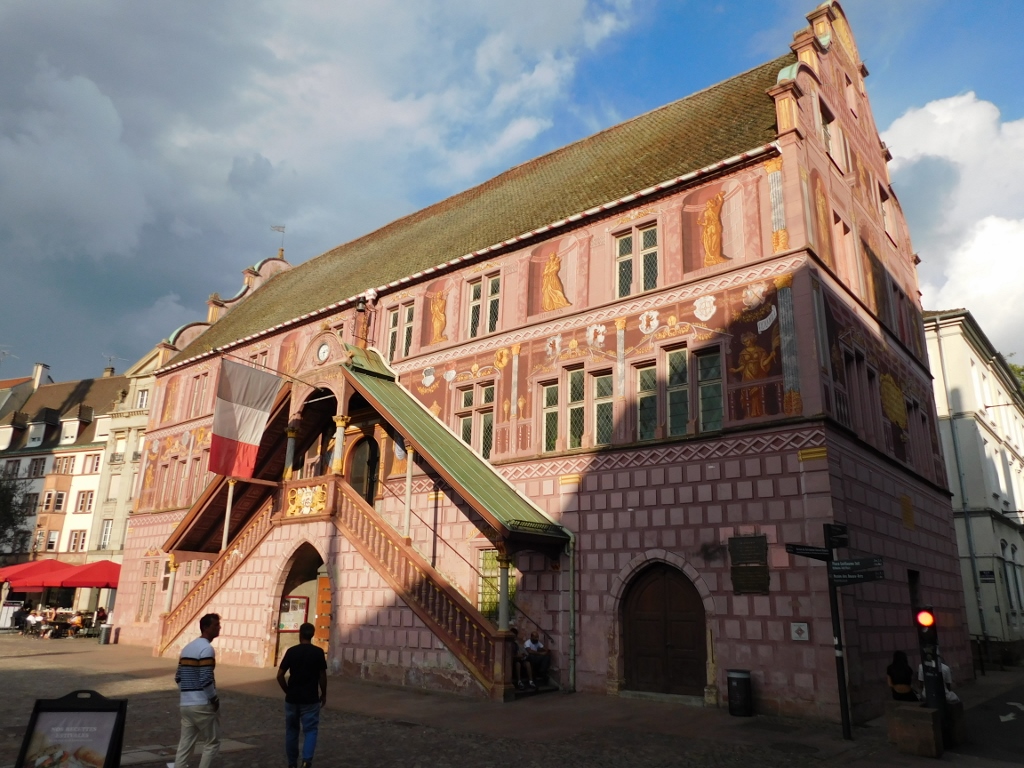 City Hall in Mulhouse
City Hall in Mulhouse
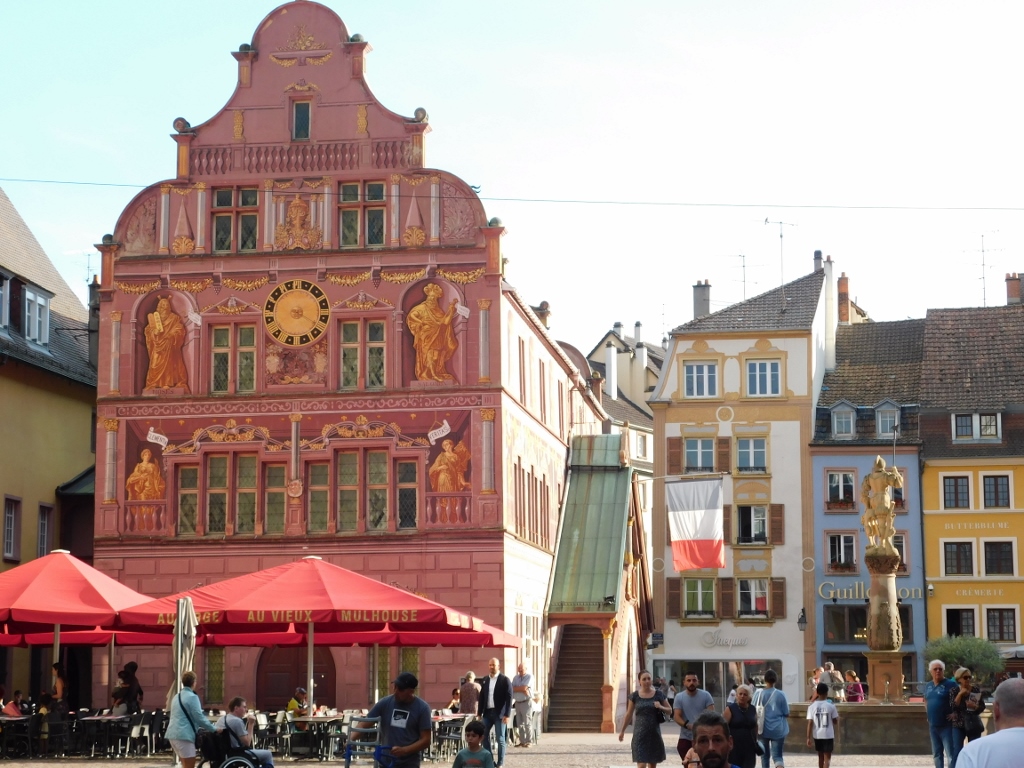 City Hall and a part of the main square in Mulhouse
City Hall and a part of the main square in Mulhouse
First I walked through the surroundings of the main square and then I decided to take a seat in one of the restaurants right here in order to have a dinner.
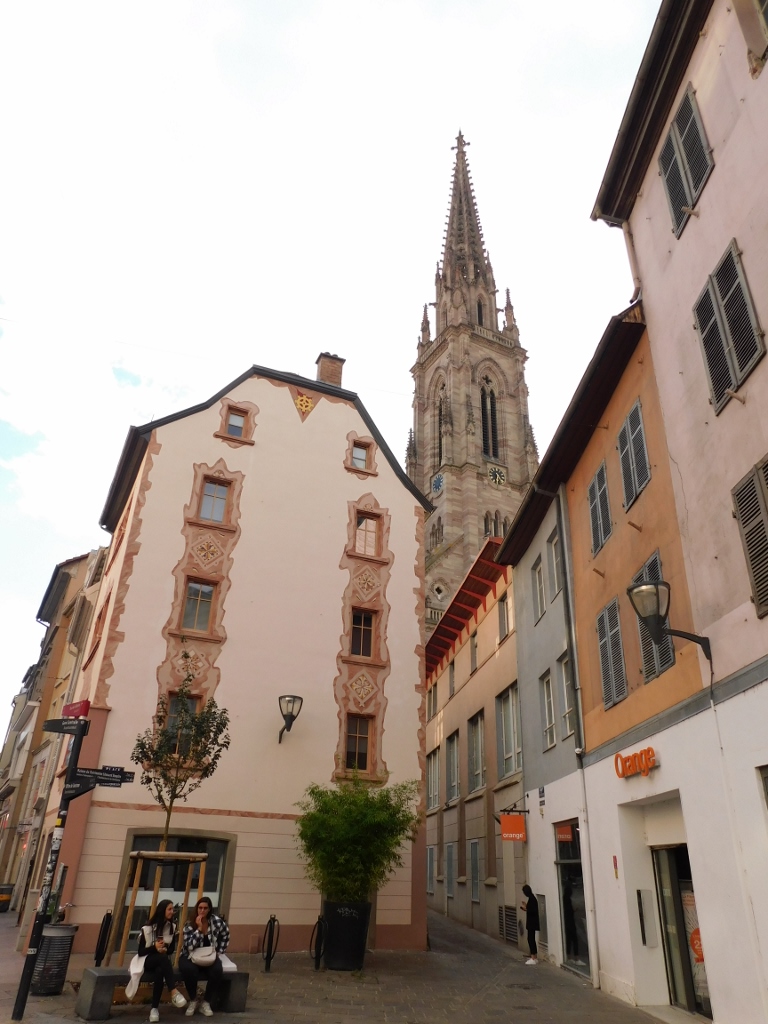 Surroundings of the main square in Mulhouse
Surroundings of the main square in Mulhouse
I wanted to eat something typical. As for the drinks, since I was so close to Germany, somehow during the entire trip I preferred beer instead of wine and this was the case here as well.
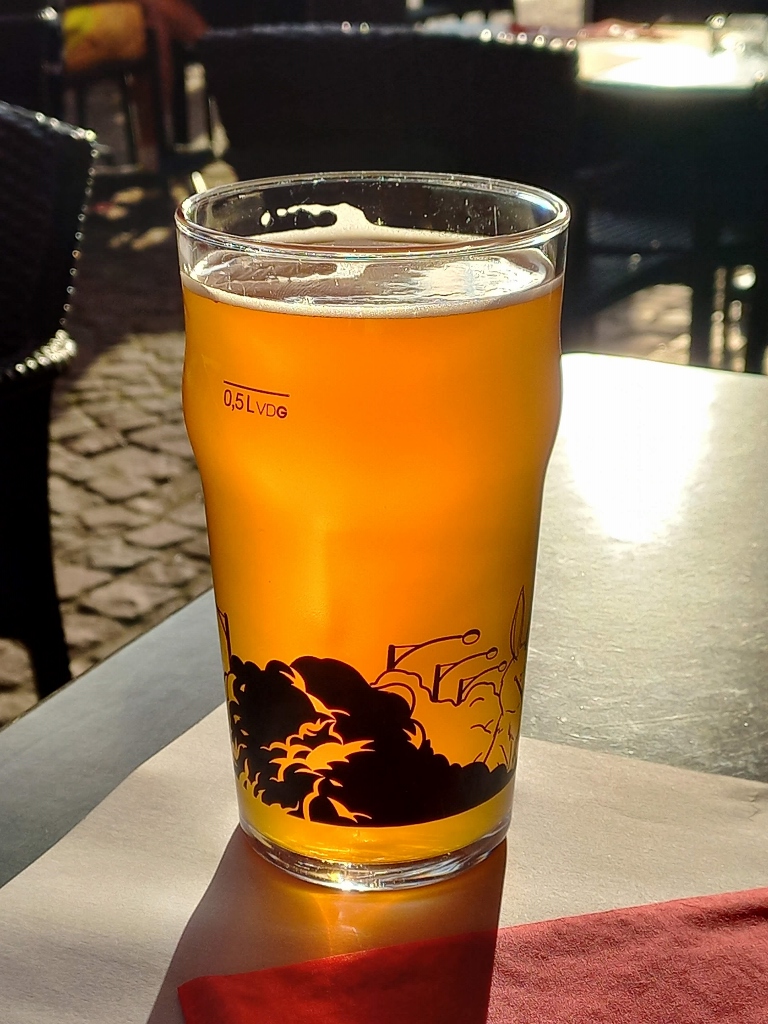 Beer in Mulhouse
Beer in Mulhouse
The ordering of the beer was easy, but there was a problem of a kind with the food, since the menu was only in French. The restaurant did have a digital multi-language version of the menu that could be scanned from the table, but this required an internet connection, while the restaurant did not offer wi-fi. So, although during these days I functioned quite well with my limited knowledge of French, anything more complicated, like choosing the right dish, was a problem. Still, I was very happy with my choice in the end.
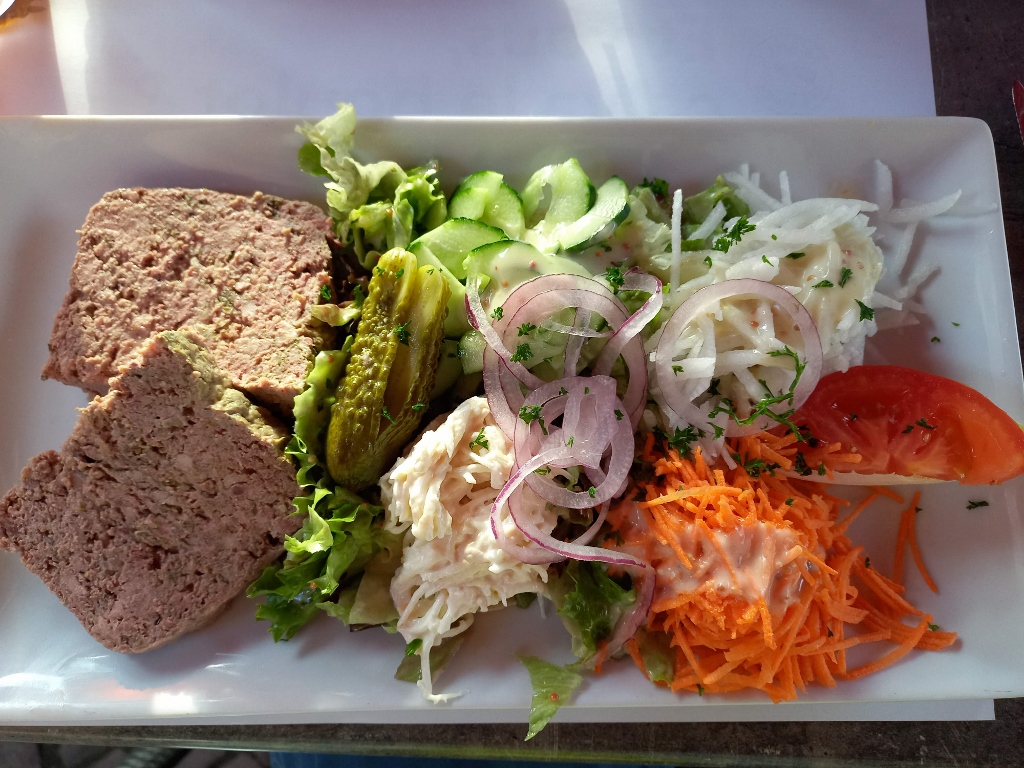 Starter of my dinner in Mulhouse
Starter of my dinner in Mulhouse
I was so happy with the starter that later, when I was back home, I made my own version of terrine. Here is a photo, as well as the recipe:
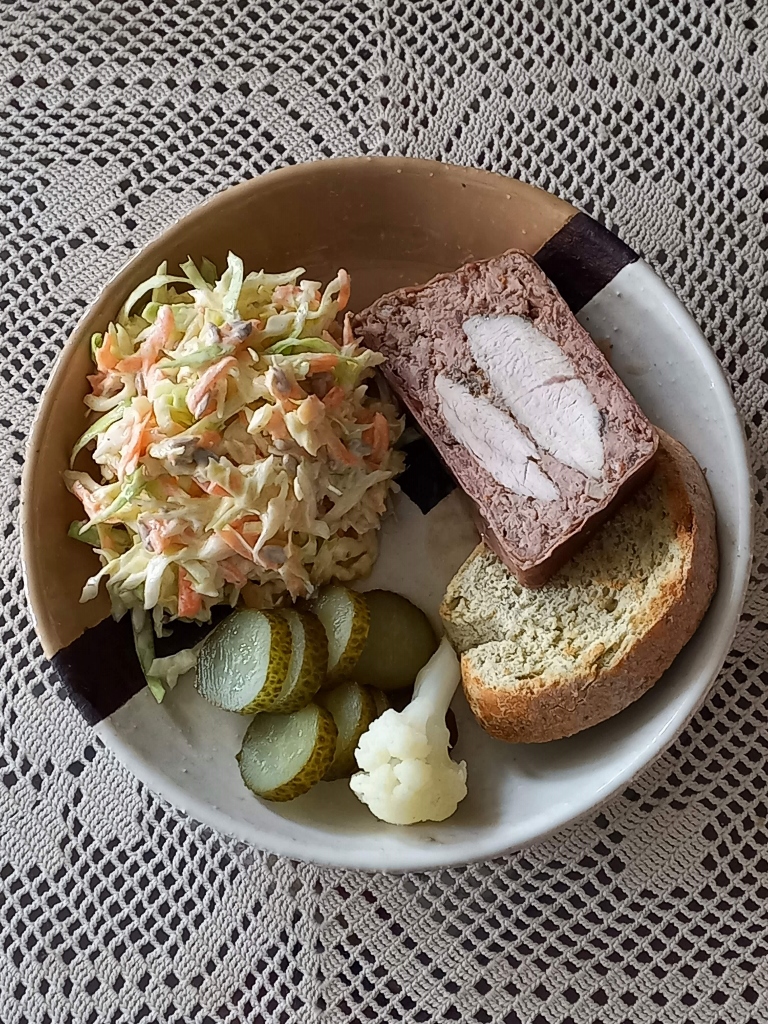 Terrine made in my way and served on a plate I had also made
Terrine made in my way and served on a plate I had also made
TERRINE
- 200 g prosciutto thinly sliced
- 500 g pork minced twice
- 200 g chicken liver
- 400 g turkey breast
- 1 onion
- 2 cloves of garlic
- 1 tsp of fresh thyme leaves
- 1/2 tsp of dry oregano
- 1 tbsp of slivovitz or cognac
- spices according to the recipe
Cut turkey breast into thick slices and season with salt, pepper and mixture of spices for poultry, as well as half a teaspoon of coriander powder. Fry it briefly using lard, then take it out of the pan and leave on the side to cool.
Add some more lard to the pan and then fry the finely chopped onion a little. Add salt and pepper. When the onions are done, add finely chopped garlic, thyme, oregano and slivovitz, frying some more and then leave to cool down.
Mince the chicken liver (you can also use an appliance for this) and then add to the minced pork. Then add the onions and bring all together using your hands.
Put baking paper into a loaf tin that will later be used in the oven in such a way that the ends of the paper stick out. It is necessary to shape the paper well in line with the shape of the tin. Then arrange slices of prosciutto over the bottom and the sides, so that they overlap a little, as well as stick out of the tin. Put 1/3 of the meat mixture on the bottom of the tin, over the prosciutto, and make sure there are no air pockets. Then arrange half of the turkey slices, the second third of the meat mixture, the rest of the turkey slices and finish with the meat mixture. When making each row, make sure everything is distributed well and there are no air pockets.
Cover with the prosciutto slices that are sticking out and then press everything well with your hand to make sure it all binds together. Then fold over the prosciutto the baking paper that is sticking from the tin and again, using your hand, check that everything is compact. Then cover it all well with two sheets of aluminium foil and put in ban-marie and in the oven at 120 degrees C for 90 minutes.
When the tin is taken out of the oven, it is necessary to press the top of the meat loaf with something heavy – tins, for instance. Let it cool and when it has cooled completely, put it in the fridge. Flip it over onto a plate the next day and cut into slices.
As for my travel, unlike the previous days, the last day was quite lazy. To start with, I stayed in the room I had rented for this trip a little longer than usual. I had my coffee, as well as breakfast that consisted of the cold leftovers of the main meal of the previous night that had been nicely packed for me at the restaurant. Even cold it was good, although the tarte flambée was much better when warm.
I was in no hurry also because it was cloudy in the morning, but after a while the sky cleared up. So, at some point I did get out and went slowly towards the centre, i.e., towards the main square. Although I had no clear plan for this first part of my day, I did get inspiration when I reached the main square called Place de la Réunion and got reminded that there were nice terraces that belonged to the surrounding cafés.
 Place de la Réunion
Place de la Réunion
I sat down in one of them and ordered coffee. Like in so many cafés and restaurants that I went to during this trip, here also they did not have wi-fi, but the waiter was very kind and told me I could use the free wi-fi of a company that had an office nearby. This functioned well and so I looked at my phone for a short while, but soon I gave it up. Instead, I realised I enjoyed a great deal in the rather aimless pondering over some ideas in my head. It was clear I was completely relaxed and that felt good at several levels.
After an undefined period of time, I did get up and first made a circle around the square and then I went to a nearby street that seemed like the main shopping area, taking into account the numerous shops.
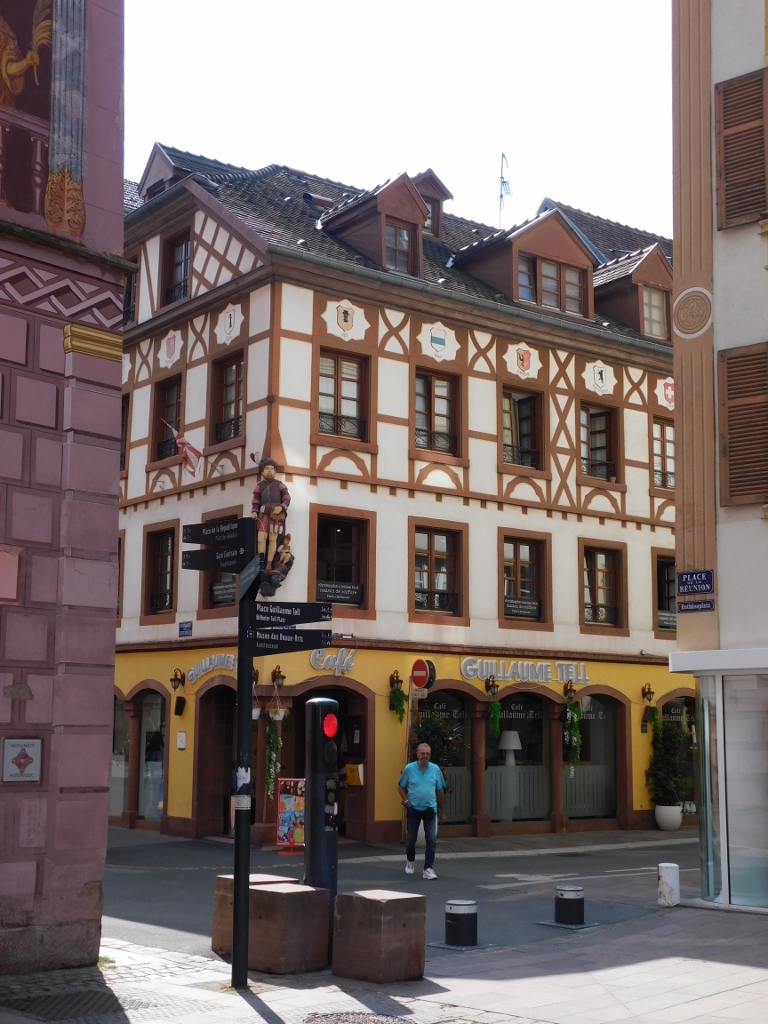 Surroundings of the Place de la Réunion
Surroundings of the Place de la Réunion
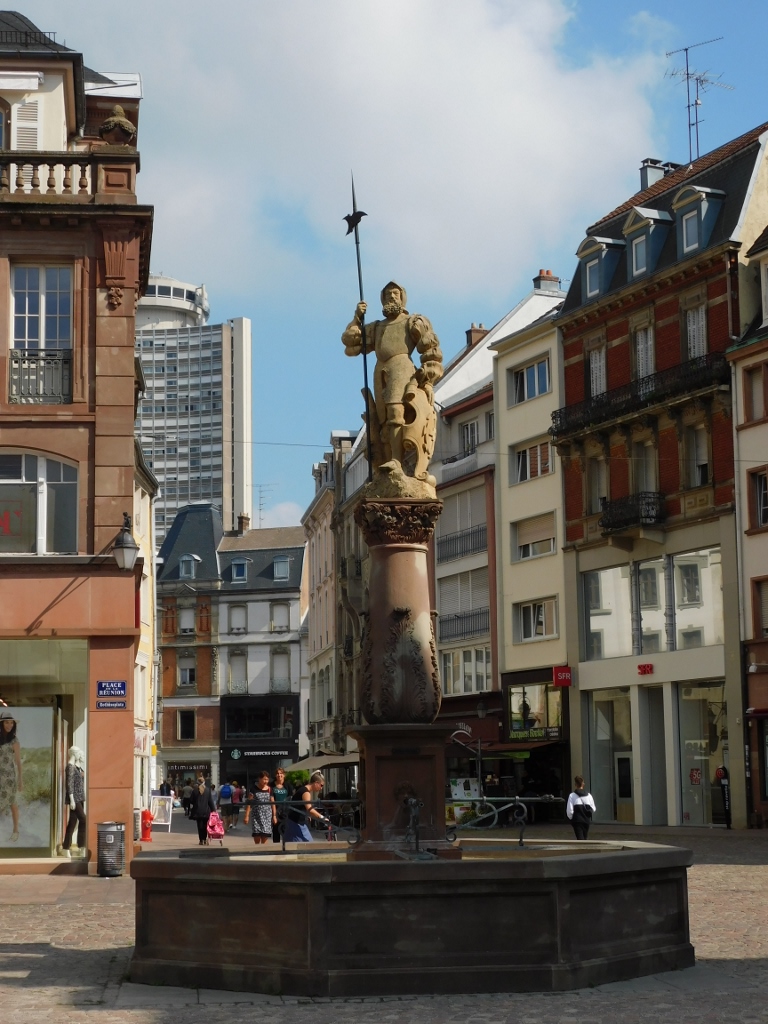 There is also a beautiful fountain in the Place de la Réunion
There is also a beautiful fountain in the Place de la Réunion
I continued with the rather aimless looking around, even entering some of the shops, but without any particular need. I was absolutely in no hurry on this day. But, Mulhouse is not a big place and even its main shopping street is not too long. When I reached the end of it, and that was in the direction that I was interested in, I finally started to move with some aim in mind.
Namely, I decided to go to the National Museum of the Automobile (Musée national de l’automobile). I must admit that originally I did not plan this at all, but Stojan and Tanja (the young man and woman from Serbia whom I met at the beginning of my stay in Mulhouse), recommended this place to me wholeheartedly. They also mentioned a train museum not far away, but although I like to travel by train, I was not interested in a museum of this kind at all. In addition, one museum felt quite enough for the day.
The Museum of the Automobile is a half an hour on foot away from the centre. This was nothing in comparison to my walks of the previous days, but, as I’ve suggested already, I was particularly lazy on this day, so I only walked to the museum. A little later, I took a tram to get back to the centre of Mulhouse.
By the way, even those who come to Mulhouse by train for a short period of time can easily transfer to the museum. One needs to take tram no. 1 that goes straight from the train station to the museum (and continues further). This takes some 5-6 tram stops and some 10 minutes ride by tram. The tram tickets are bought at vending machines that are installed on all stops and it is important to validate the ticket as soon as you get in.
But, as I’ve said, I walked to the museum. On the one hand, I’m glad I did this lest I felt I had missed out on something, but on the other one, I would not miss out on anything, because I was following a rather uninteresting street.
As for the museum, it was created out of the collection made by the Schlumph brothers. They were the owners of a company for spun woollen products (founded in 1935), as well as of a spinning-mill. Even after World War II, they continued to develop their business and became very wealthy. But, they were also major fans of automobiles and so they started to build their collection. As for the factory, it had a very stormy end, since the brothers had enormous debts and even had to flee to Switzerland, but the collection was classified as the historic monument in 1978 and was thus saved. Meanwhile, all sorts of other things happened, but the point is that today the visitor can come to this museum in Mulhouse which is, in fact, exceptionally interesting, even for the people who are not particularly focused on cars.
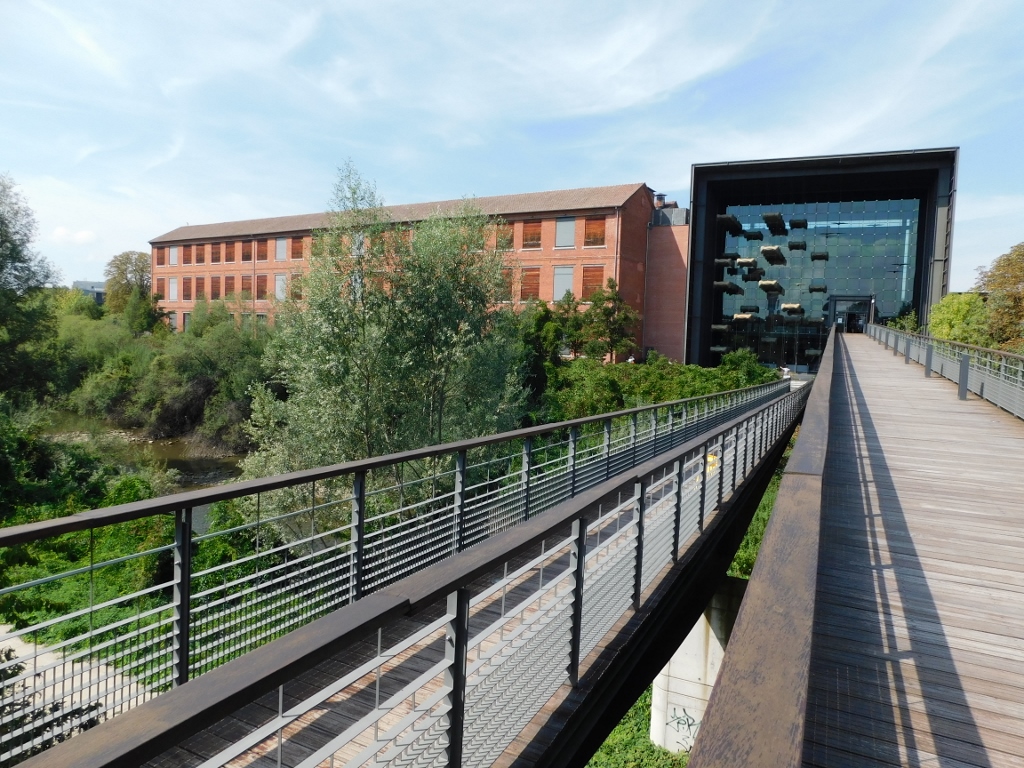 National Museum of the Automobile
National Museum of the Automobile
Before I started to look at the collection itself, I got out to a flanking area where different cars are displayed. These can be driven around the test track that exists here. All one has to do is to have the driving licence, choose the model and pay.
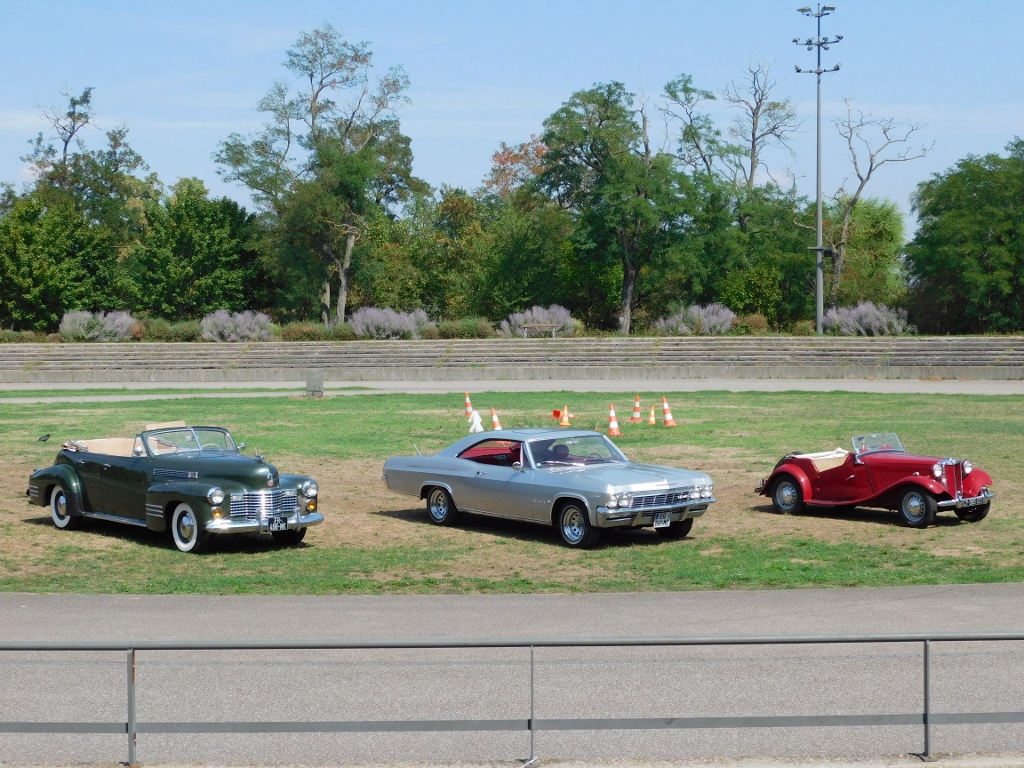 National Museum of the Automobile
National Museum of the Automobile
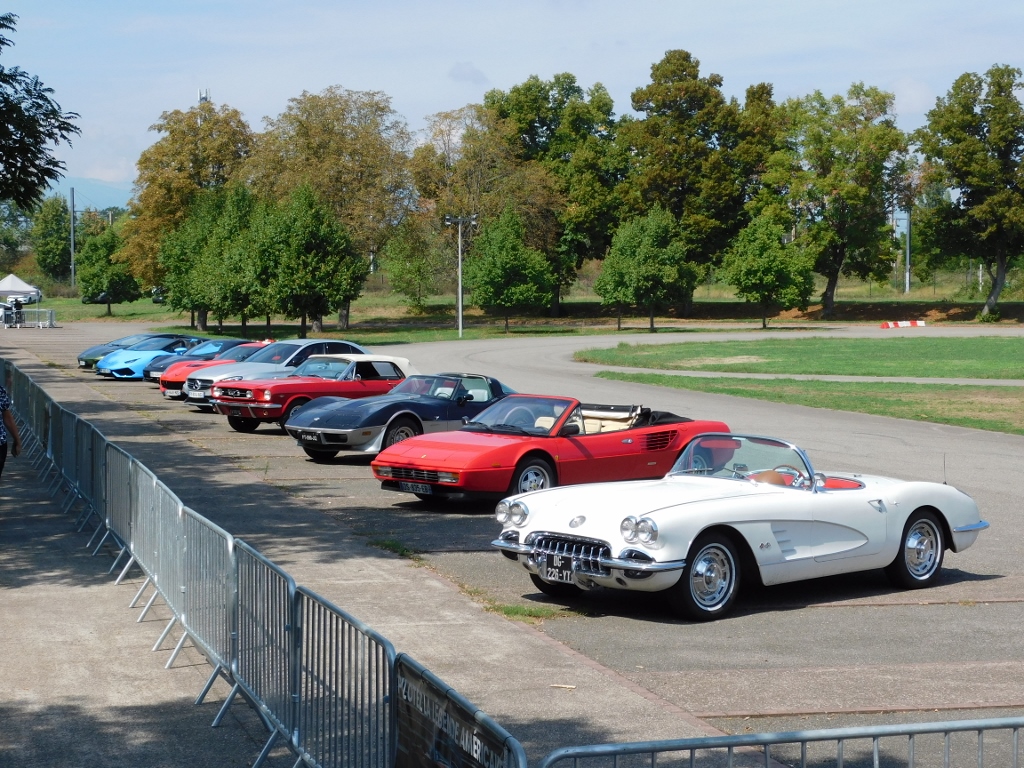 National Museum of the Automobile
National Museum of the Automobile
Here is also the pricelist from August 2022.
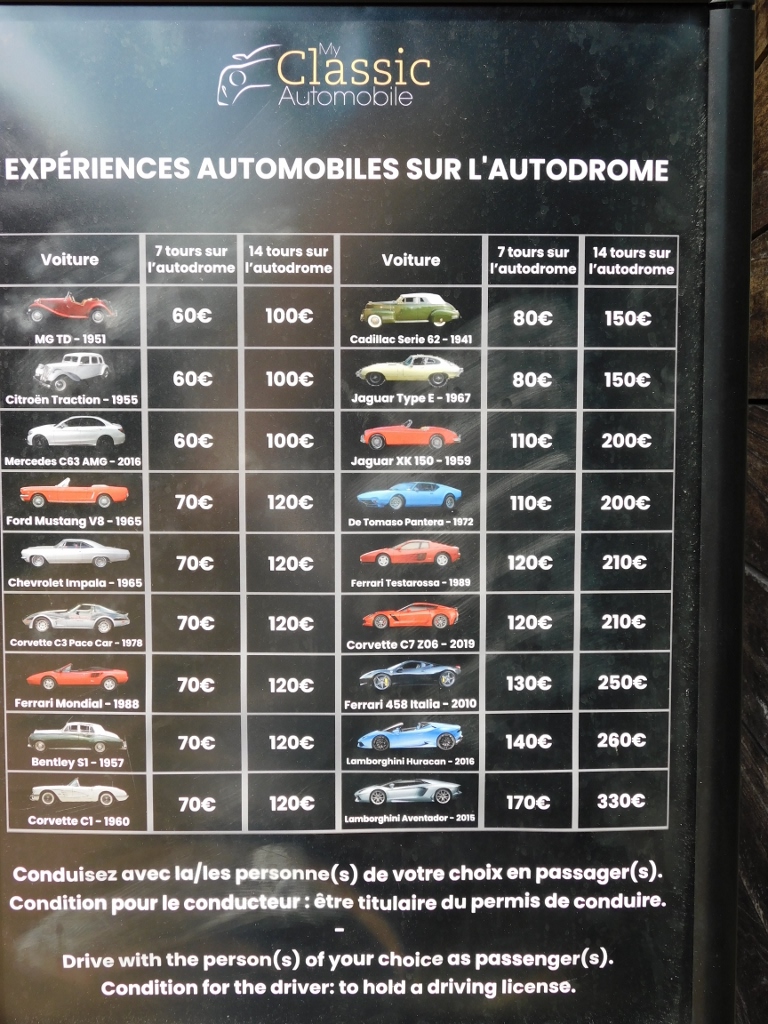 National Museum of the Automobile
National Museum of the Automobile
As for the collection itself, it is truly impressive. At first, I wondered around randomly, until I realised there were big numbers clearly marked on the floor suggesting the order of the visit. It does make sense to follow this proposal. Here is just a small selection of the cars I took photos of.
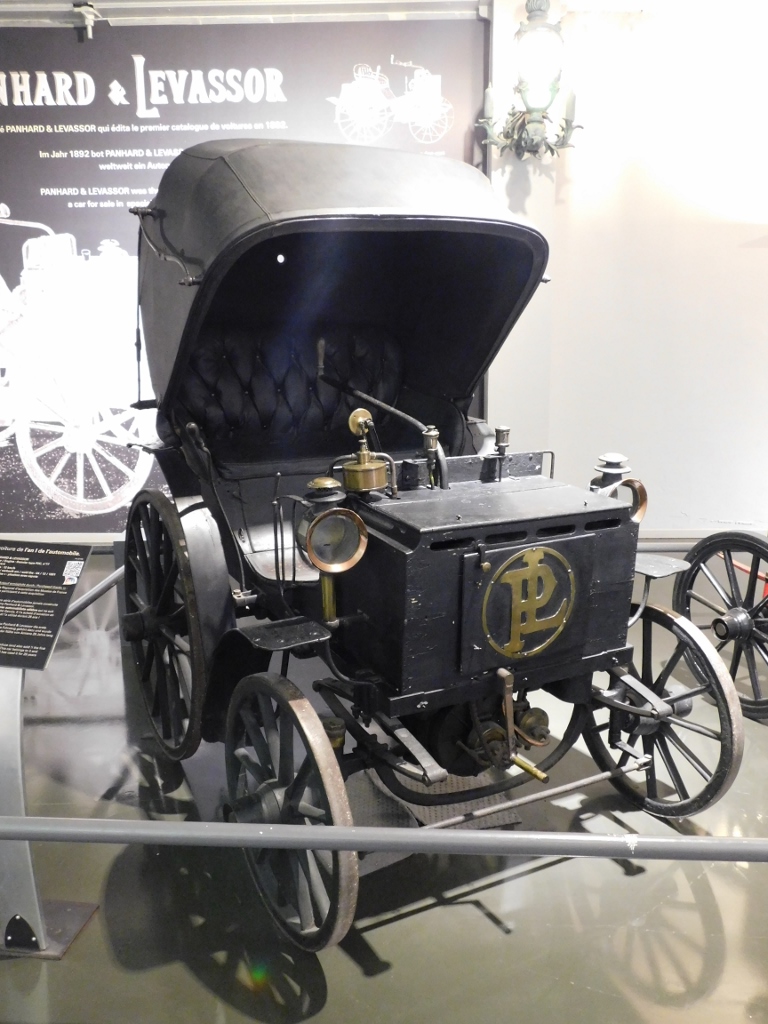 Car from 1891
Car from 1891
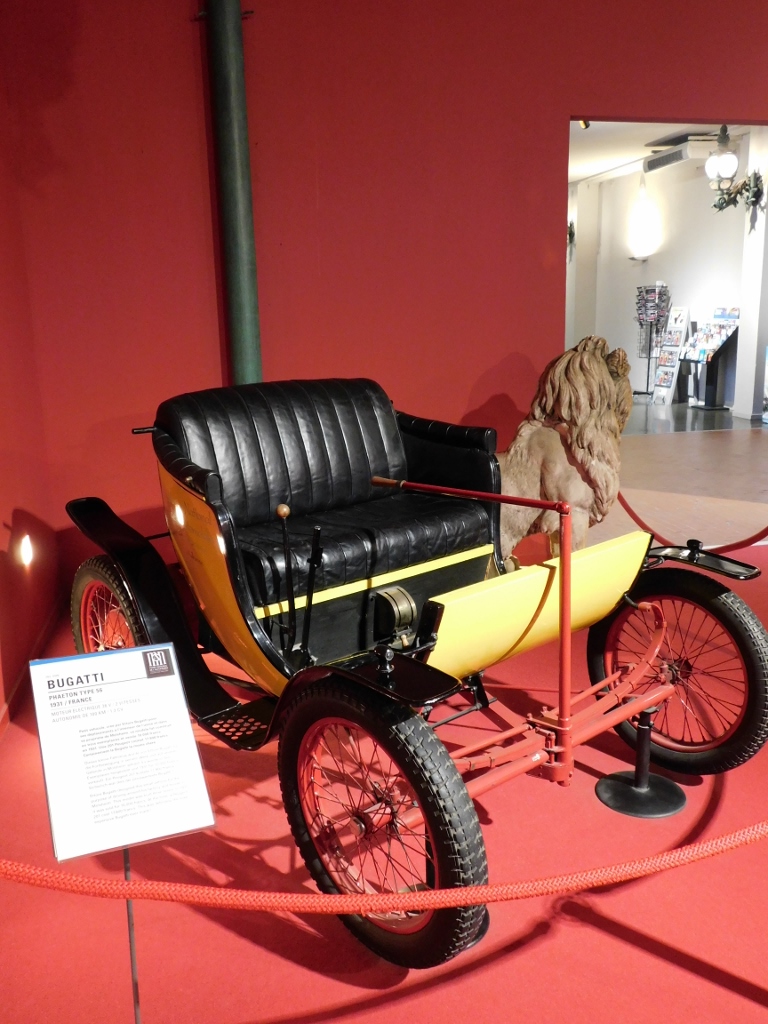 National Museum of the Automobile, a detail
National Museum of the Automobile, a detail
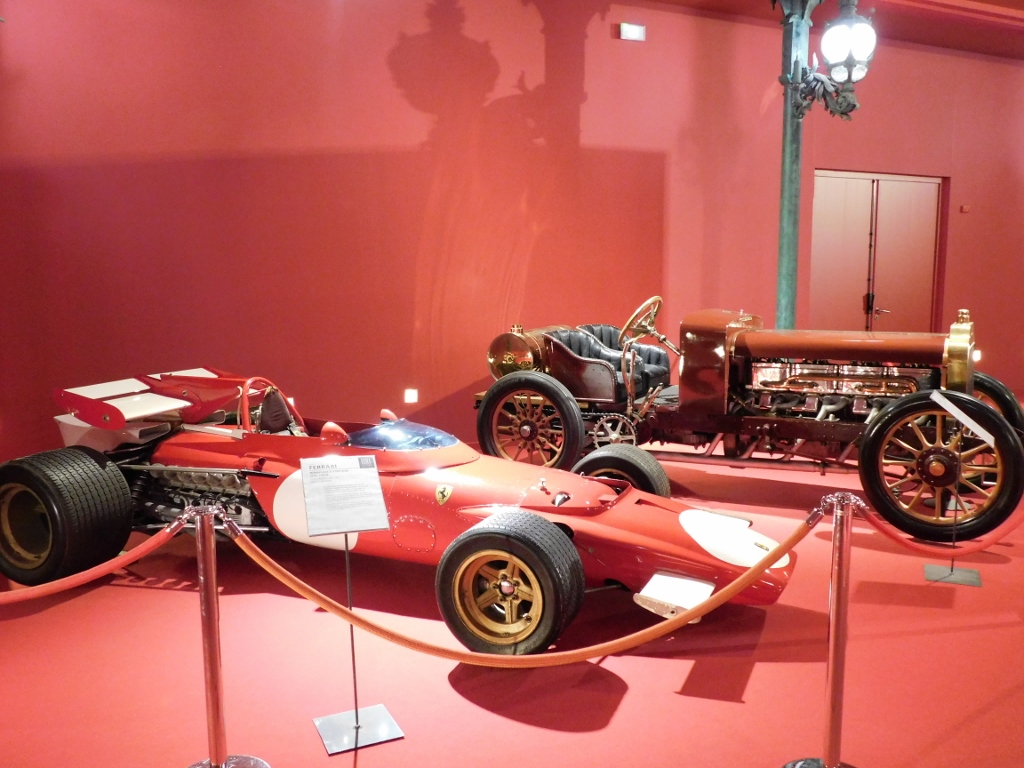 National Museum of the Automobile, a detail
National Museum of the Automobile, a detail
 National Museum of the Automobile, a detail
National Museum of the Automobile, a detail
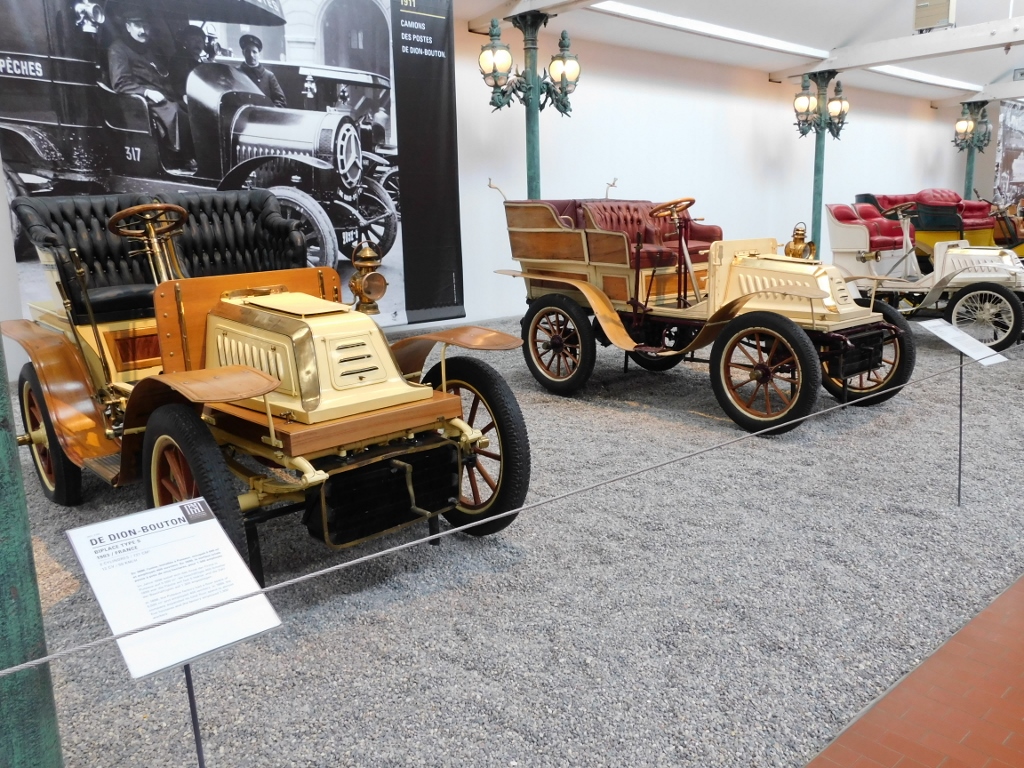 National Museum of the Automobile, a detail
National Museum of the Automobile, a detail
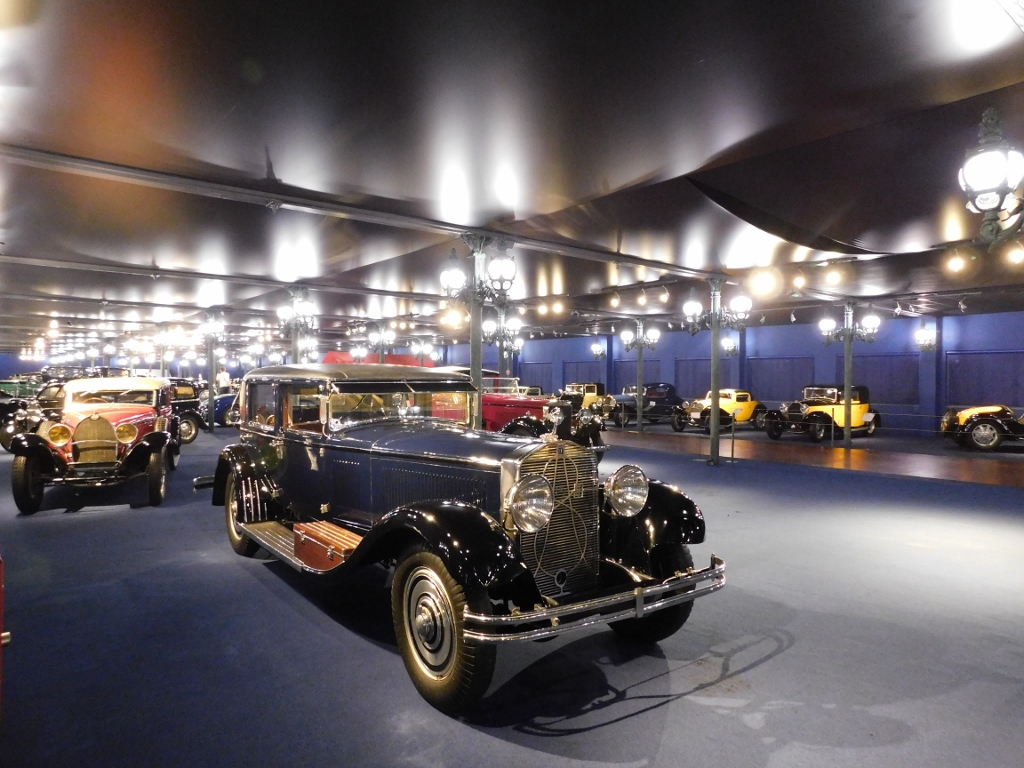 National Museum of the Automobile, a detail
National Museum of the Automobile, a detail
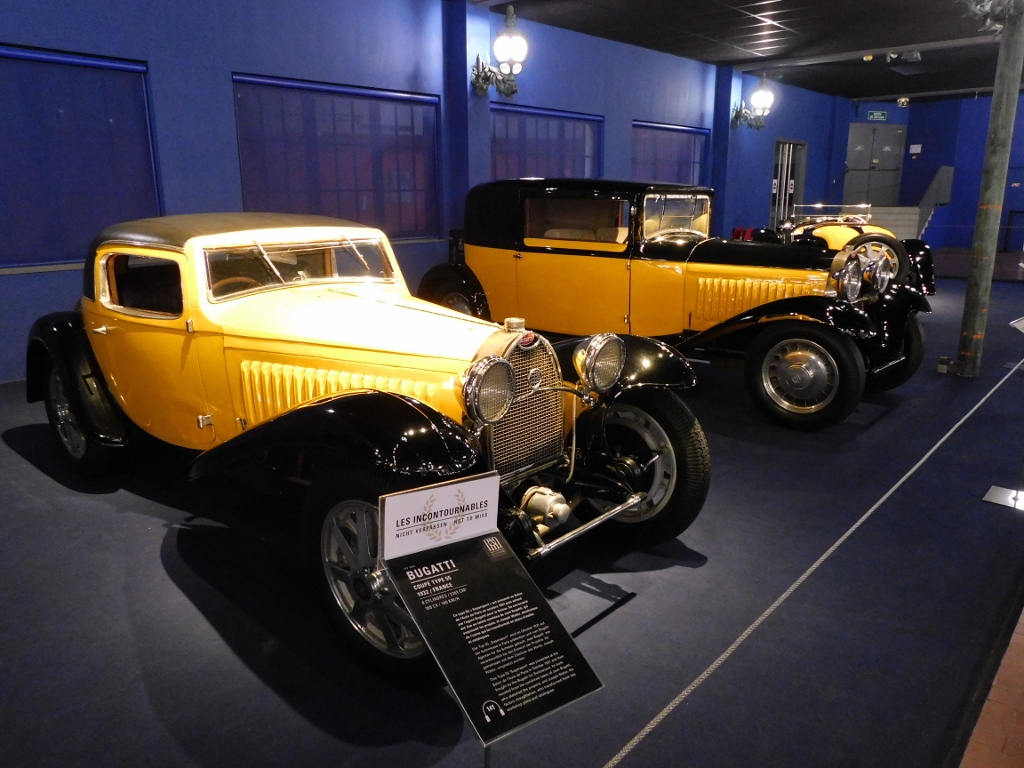 National Museum of the Automobile, a detail
National Museum of the Automobile, a detail
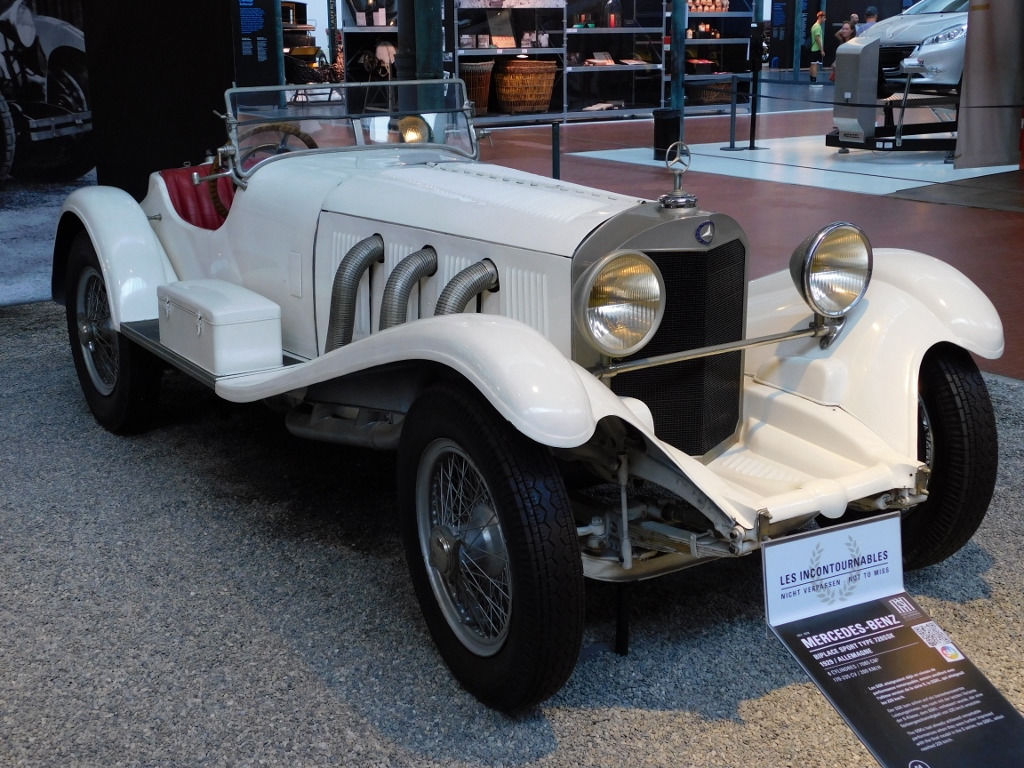 National Museum of the Automobile, a detail
National Museum of the Automobile, a detail
Needless to say, not all the cars are from the first half of the 20th century, some are also from the second half, like the two specimens in the photo below.
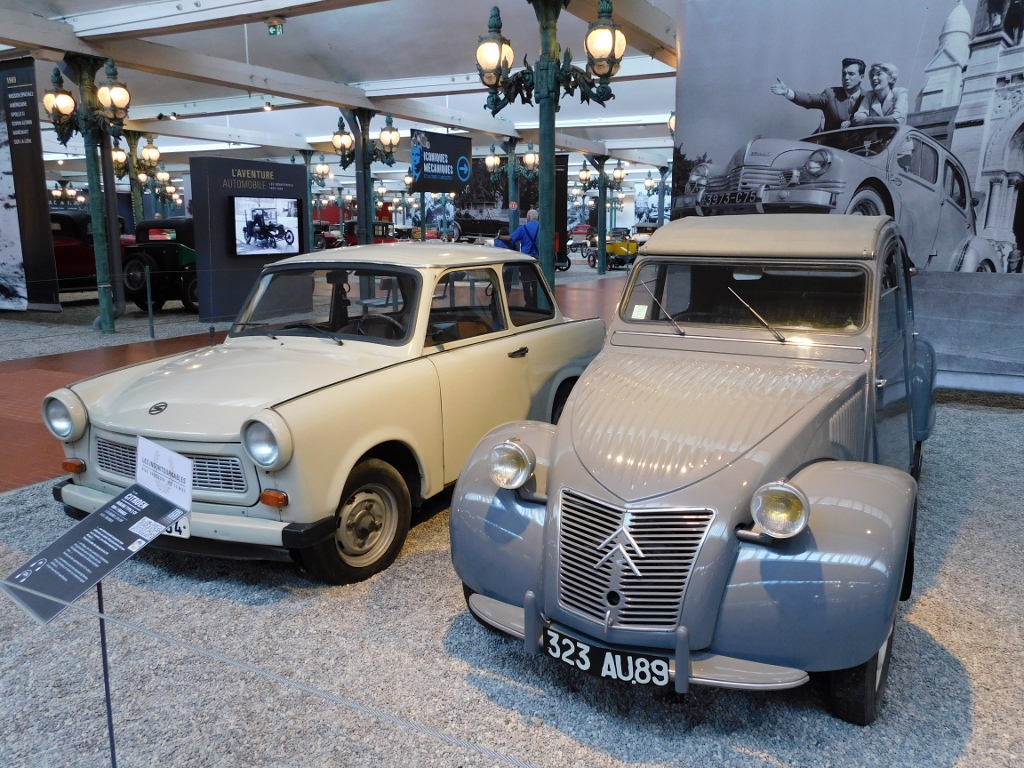 National Museum of the Automobile, a detail
National Museum of the Automobile, a detail
On the left-hand side is a Trabant from 1986 the body of which used to be made of Duroplast, which was the subject of numerous jokes around the world. On the right-hand side, there is a Citroen 2 CV from 1954. Beside this car, there is an information board saying that the specifications for this car used to state that it could transport “two clog wearing farmers, 50 kg of potatoes, or a barrel, at a maximum speed of 60 km/h.”
Yes, it was great fun coming to this museum!
After the visit to the museum, I took a tram to return to the centre where I walked some more and then I went for a light lunch that turned out to be an improvised one, since it was almost 3 pm and the kitchens of typical French restaurants are already closed by this time as far as the lunch is concerned.
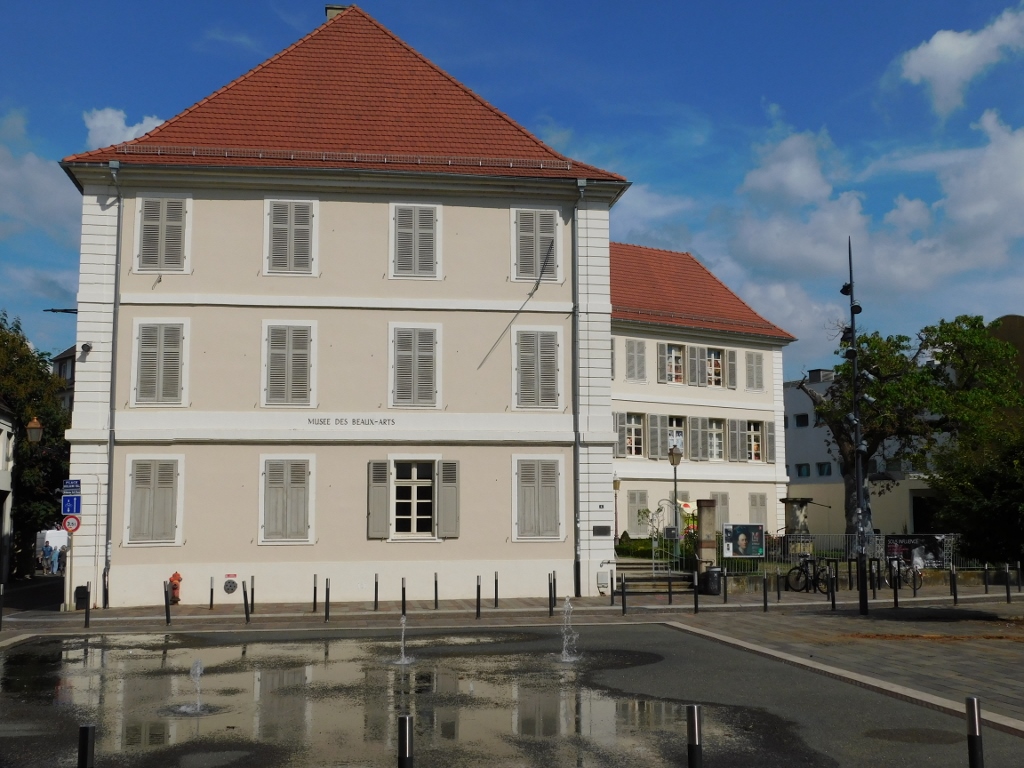 The Fine Arts Museum in Mulhouse
The Fine Arts Museum in Mulhouse
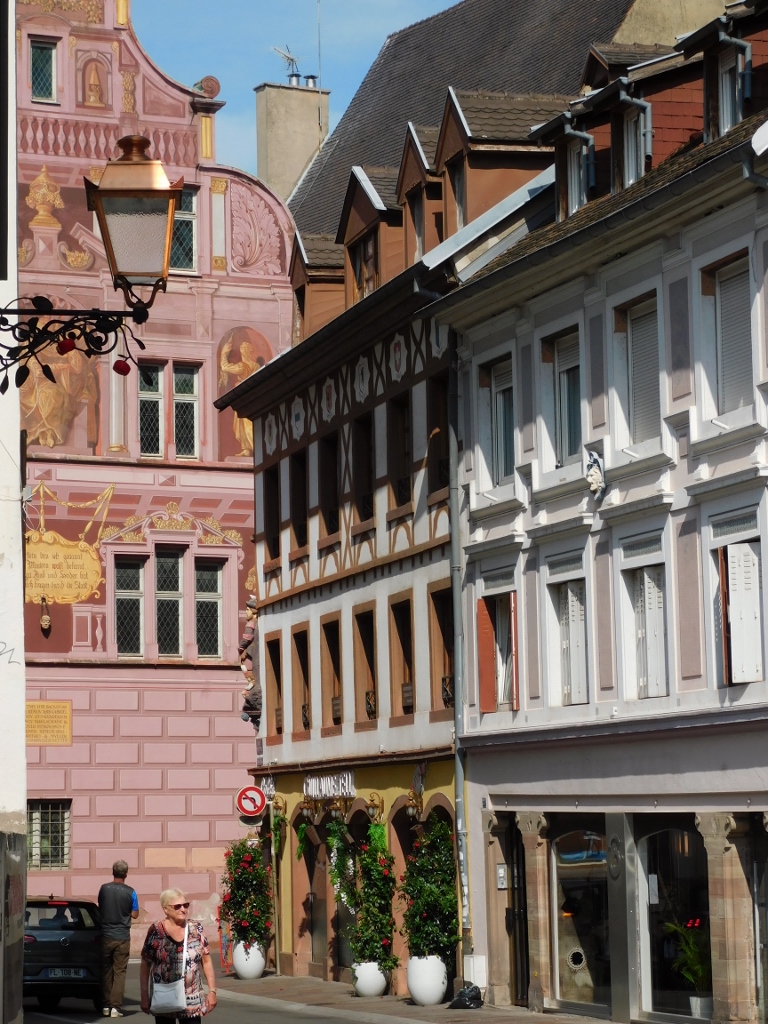 Mulhouse, a detail
Mulhouse, a detail
On the other hand, the cafés seem to work at any time of the day, so I went for yet another coffee at the main square still enjoying the loveliness of some of the buildings that can be seen around. There are not many of them, as is the case with most of the other places I visited during this trip, but I enjoyed nonetheless.
While returning to my room, I bought a few small items and then I could pack nicely.
The trip back to the airport and further to my home was eventless. And then, later in the evening, as I was getting ready to go to bed, I had a lingering smile on my face that reflected the pleasure at having visited nicely this exceptionally interesting and picturesque part of Europe.